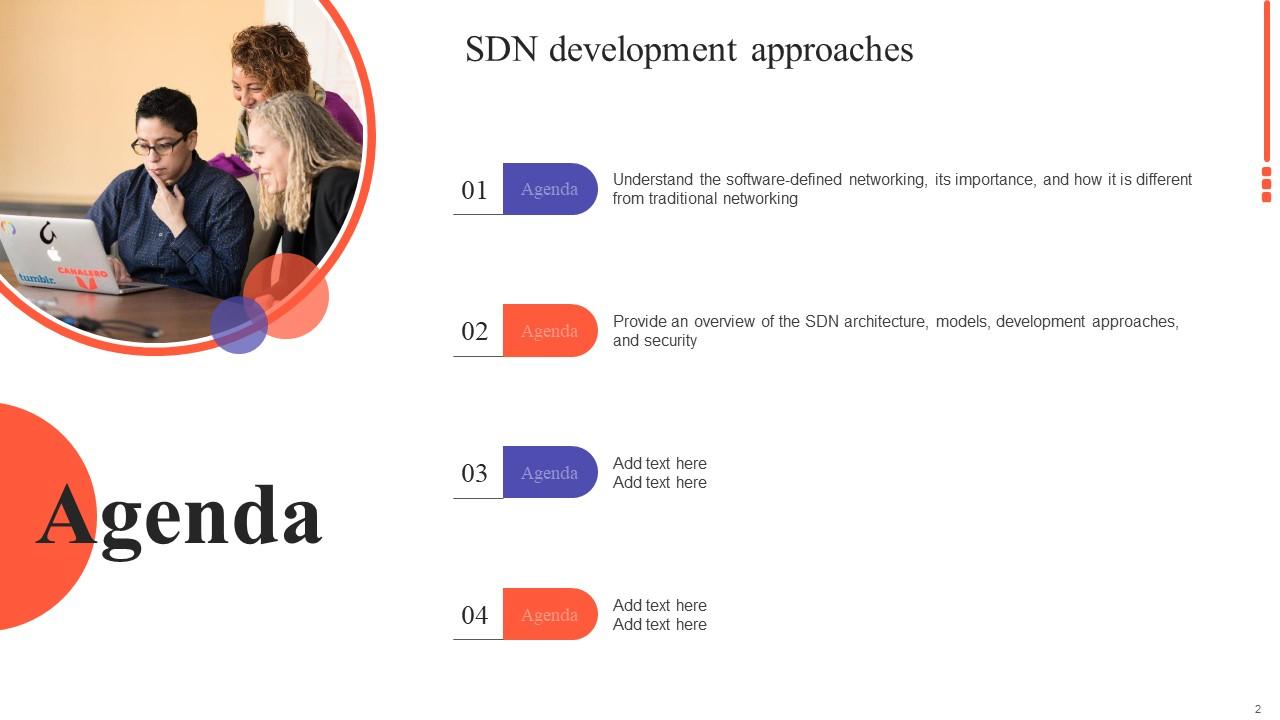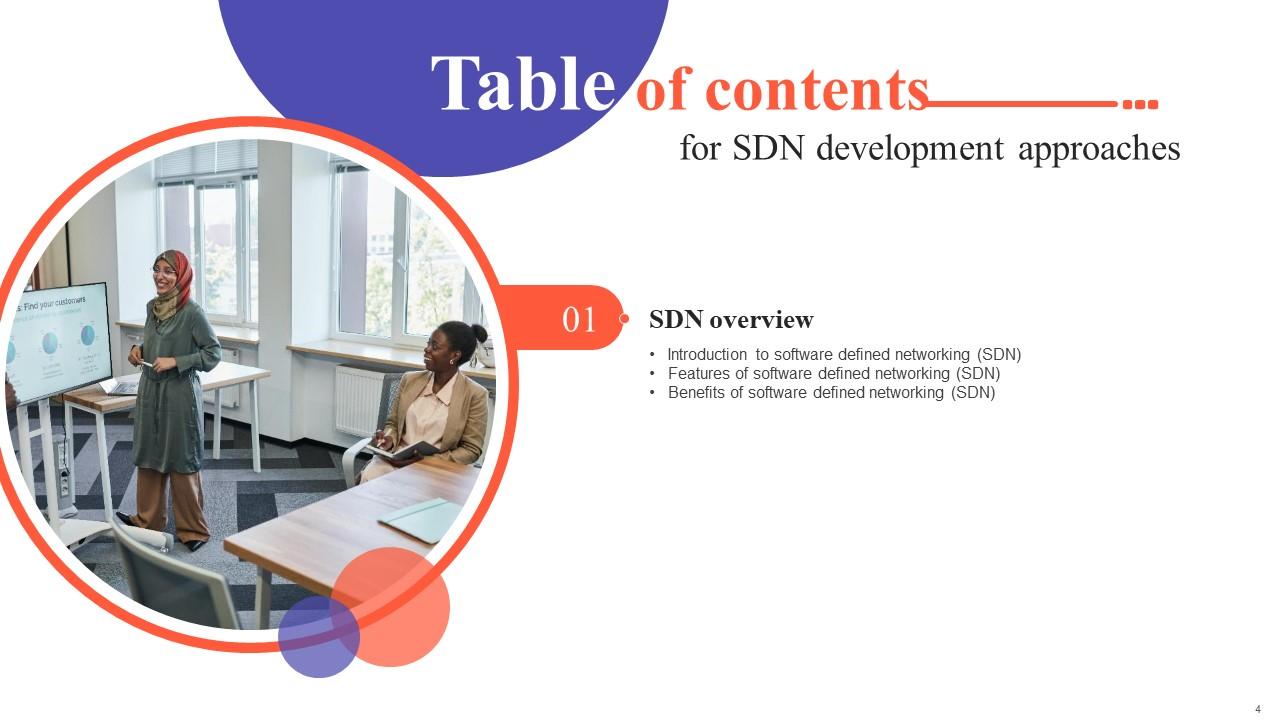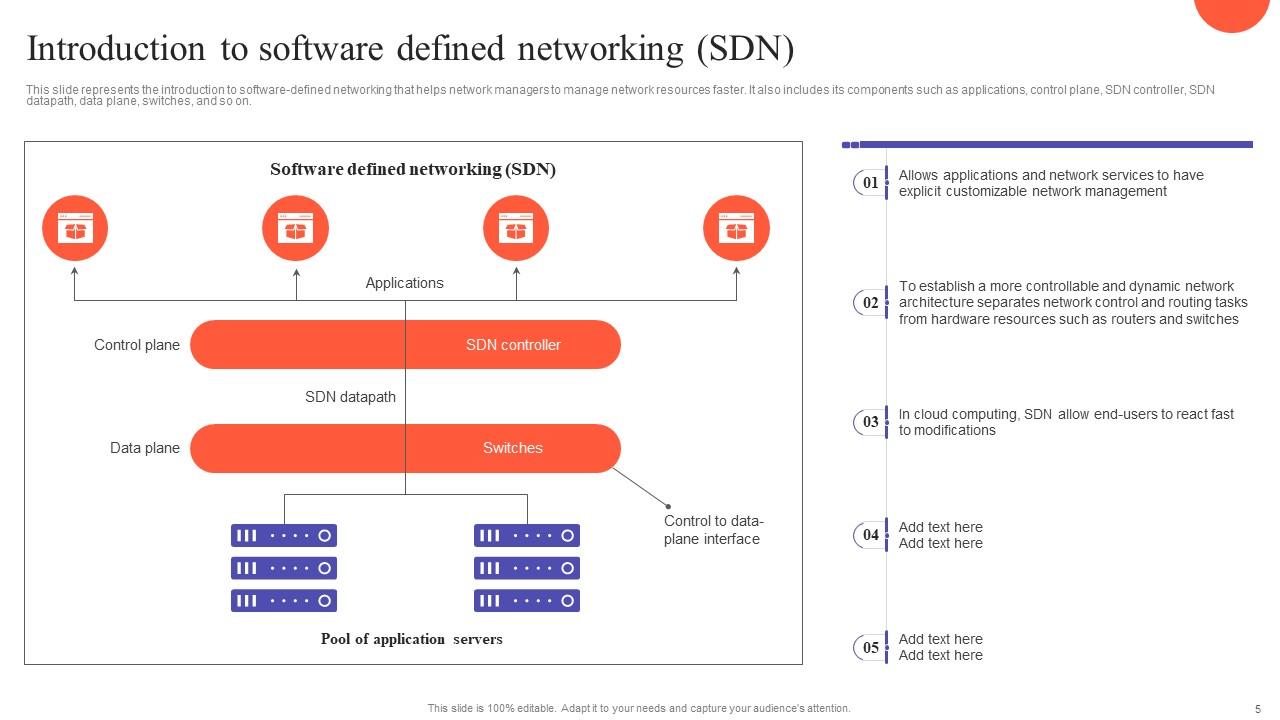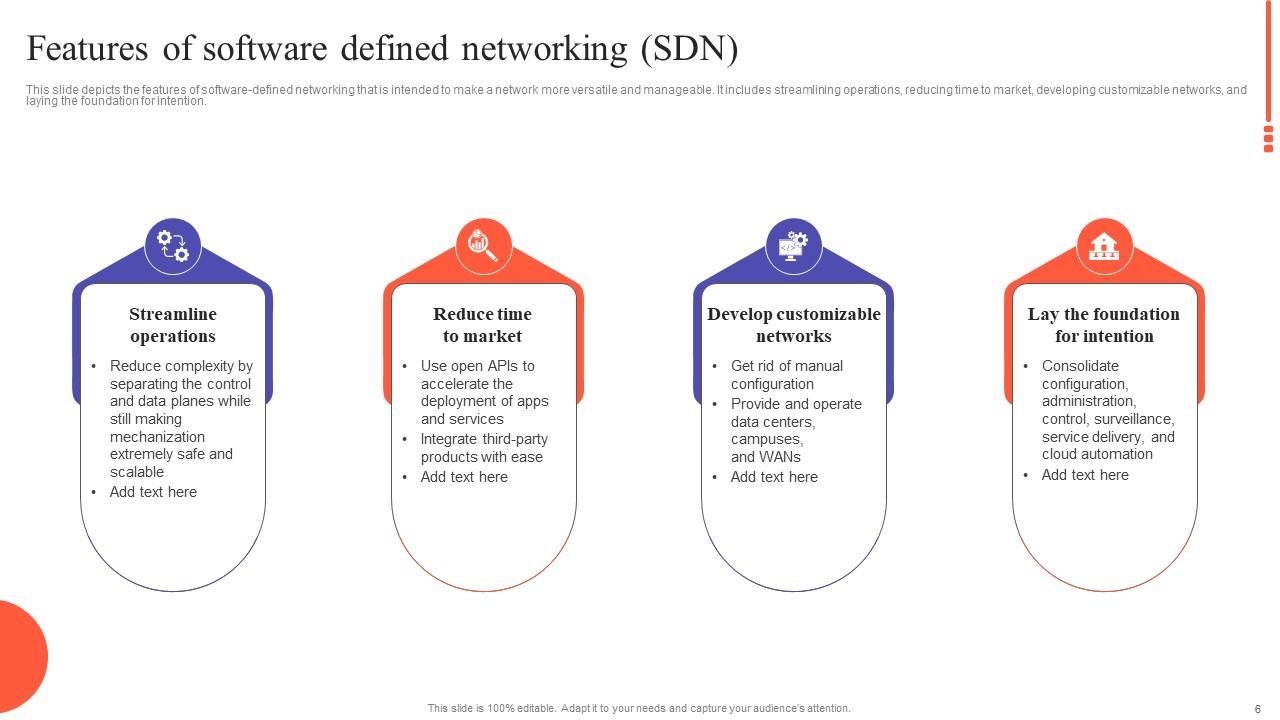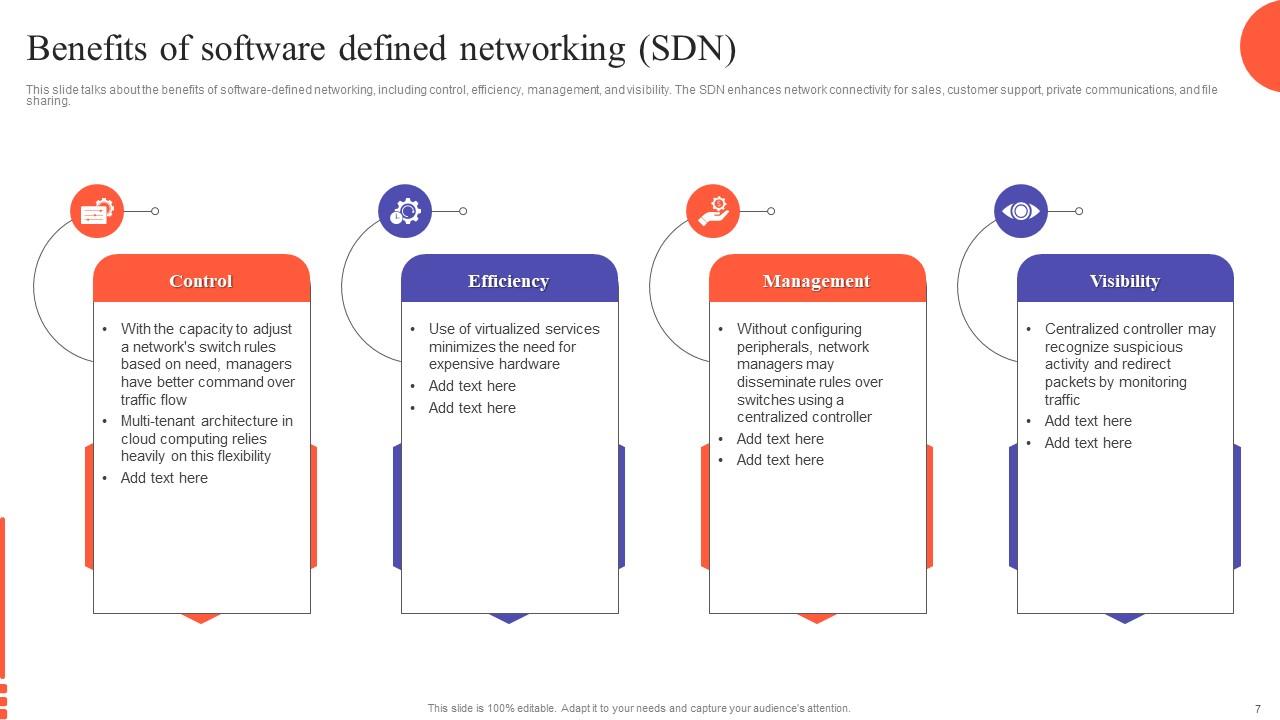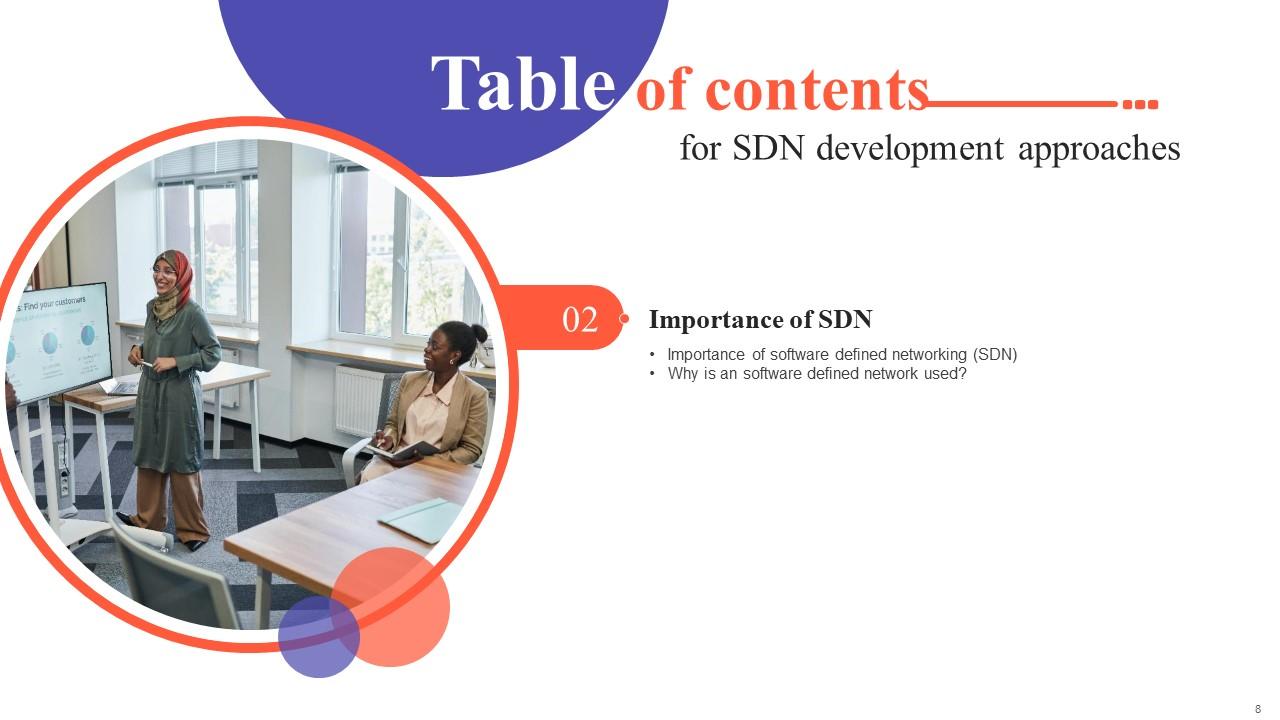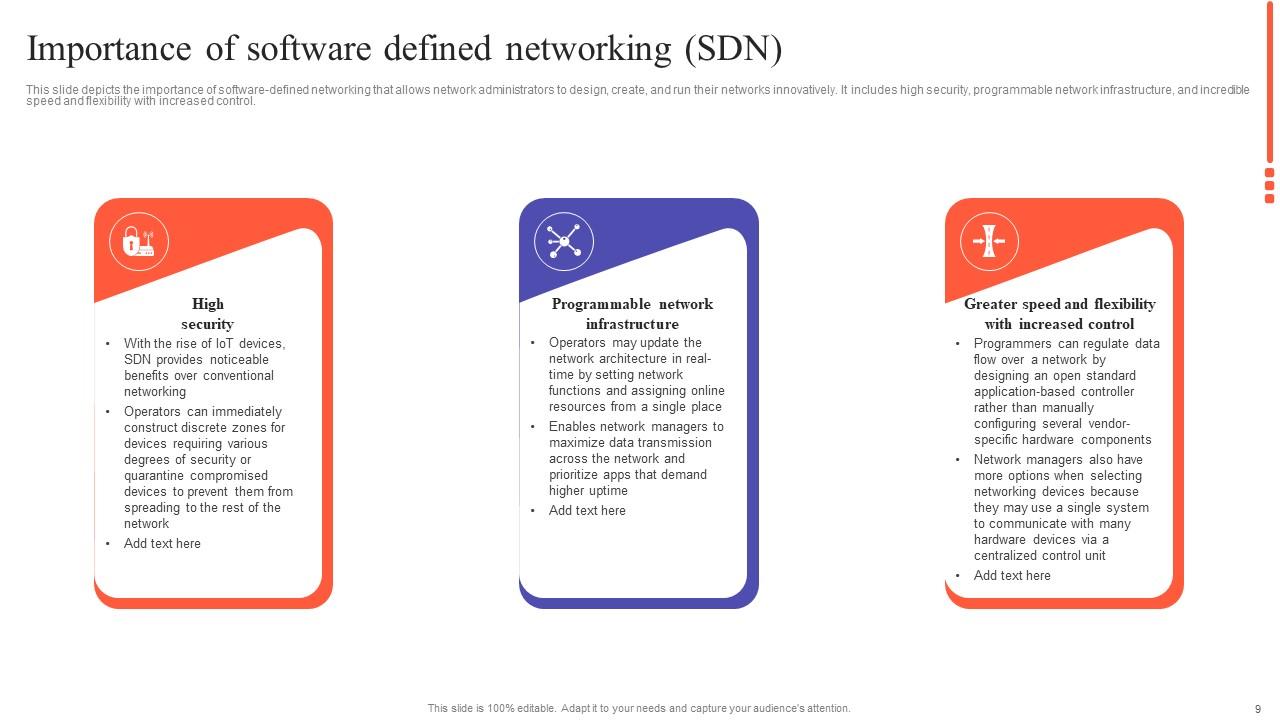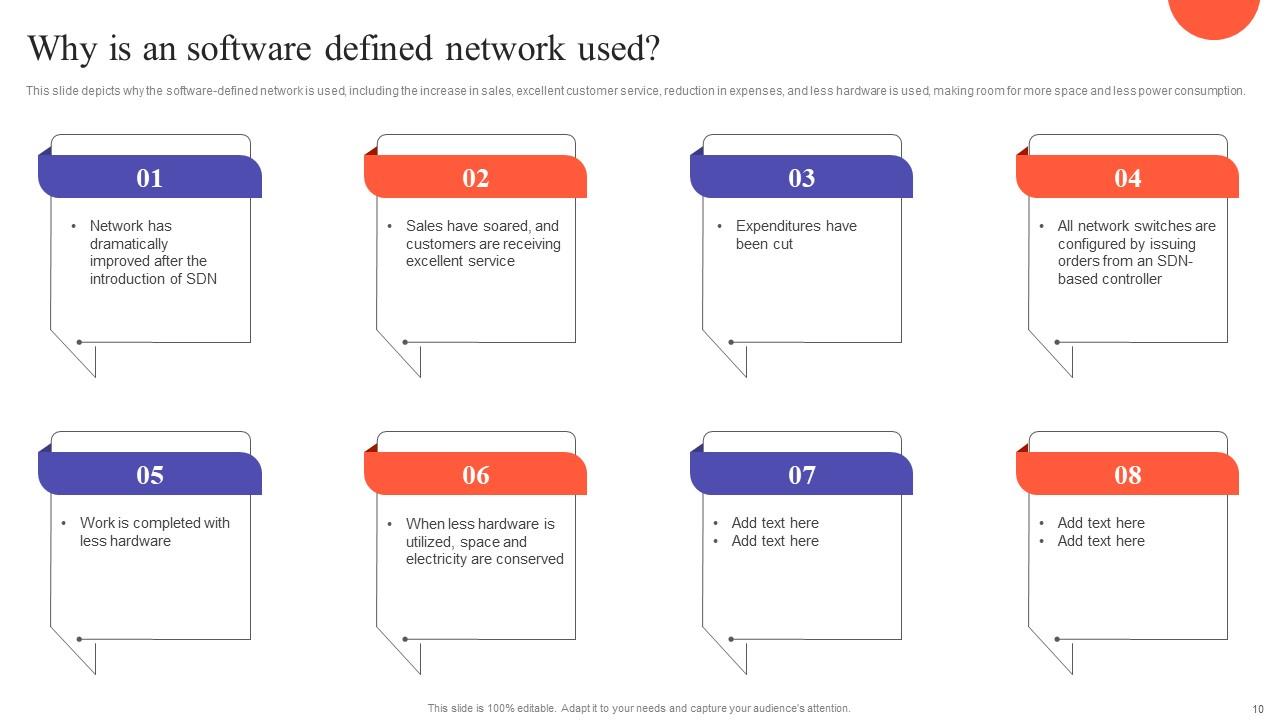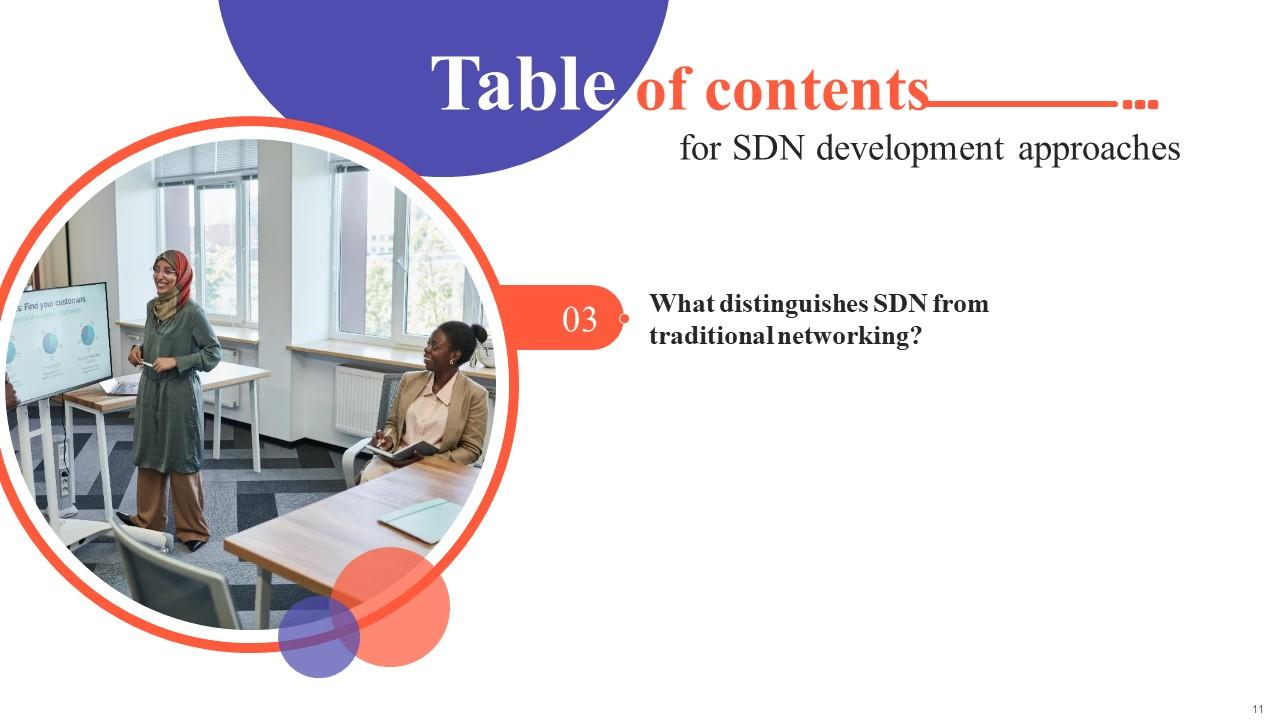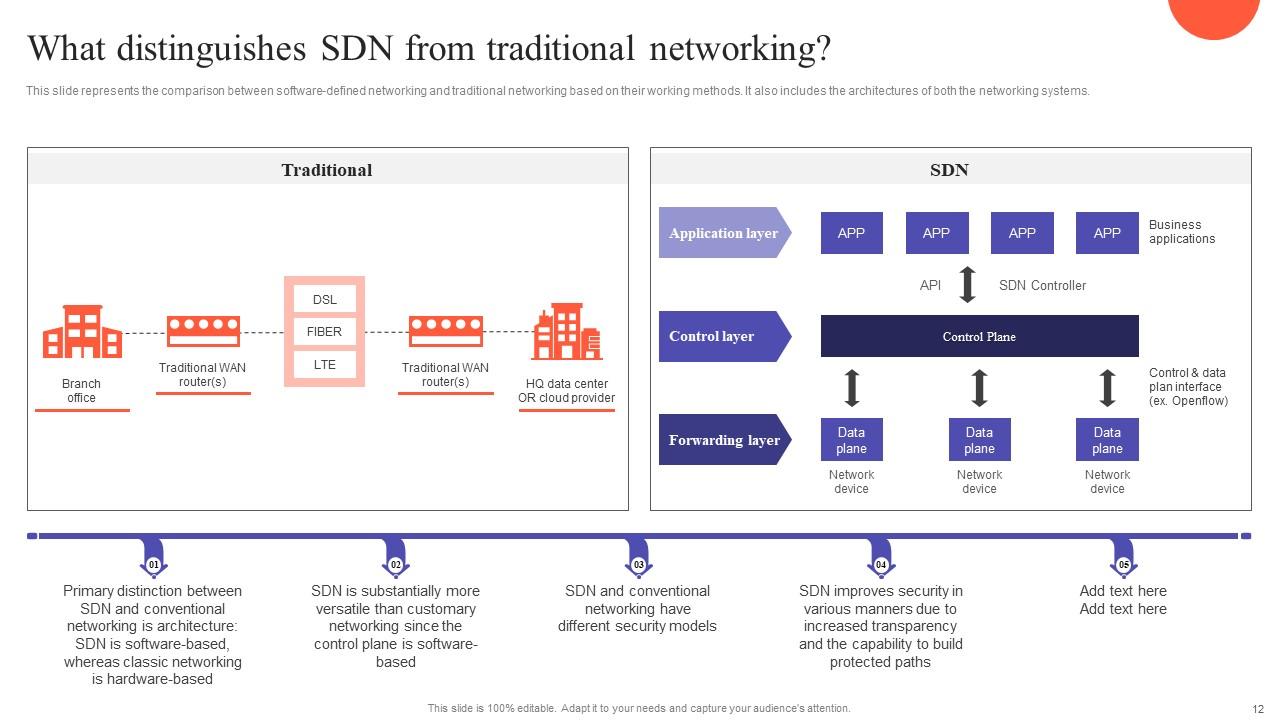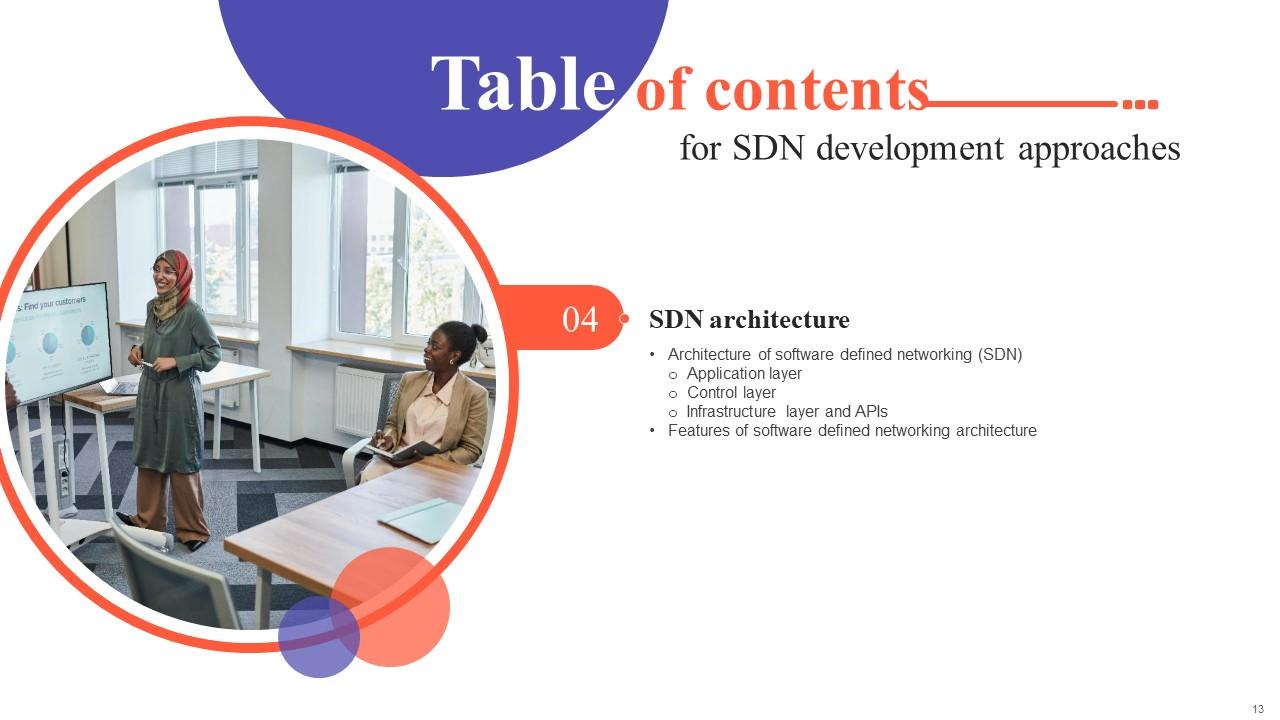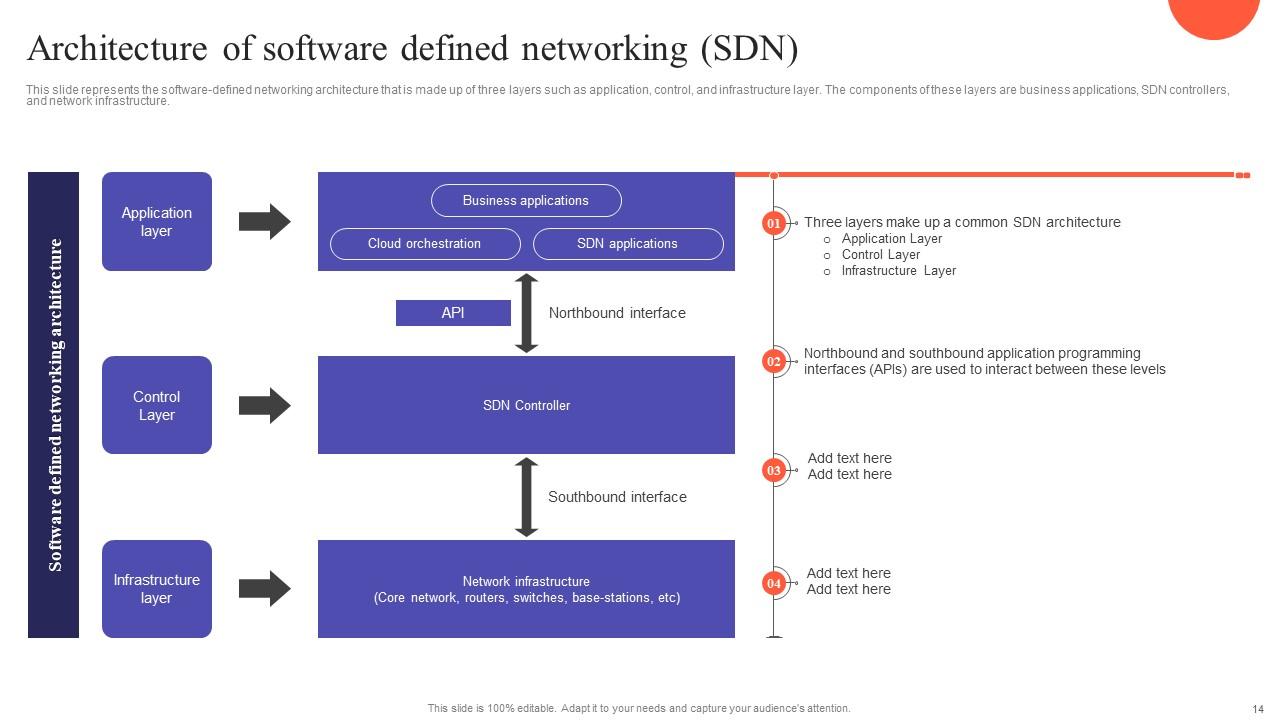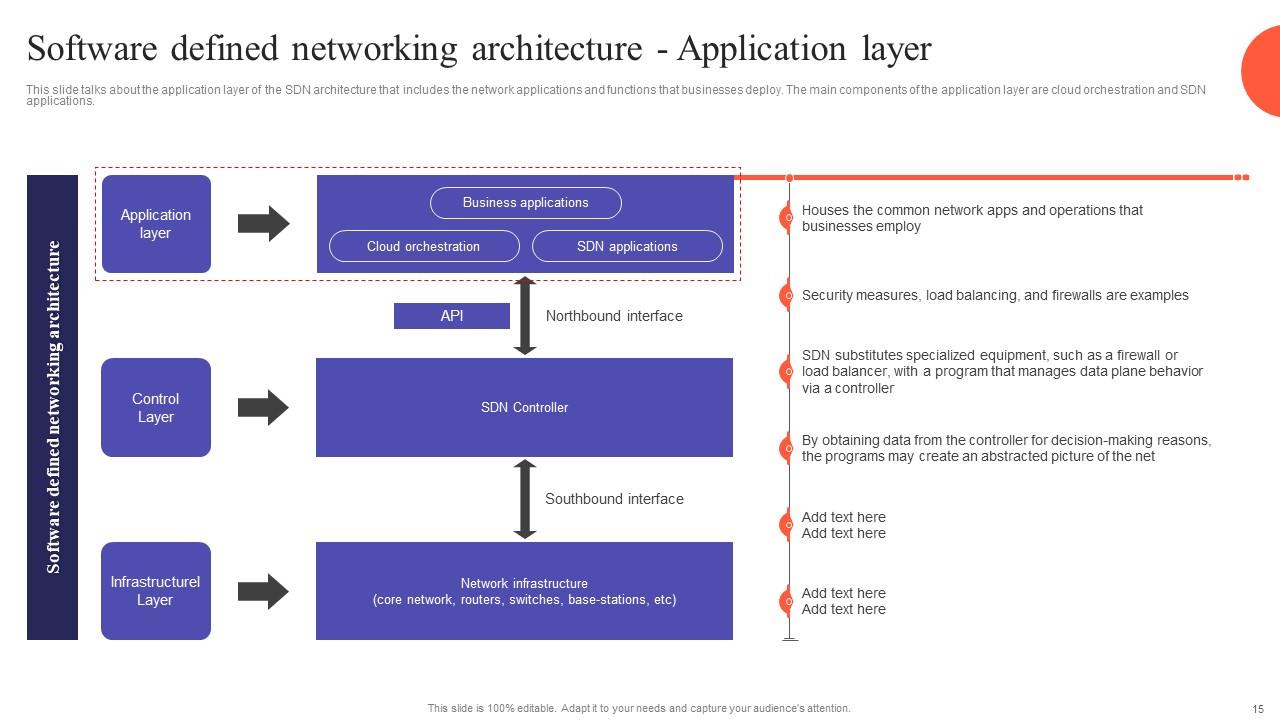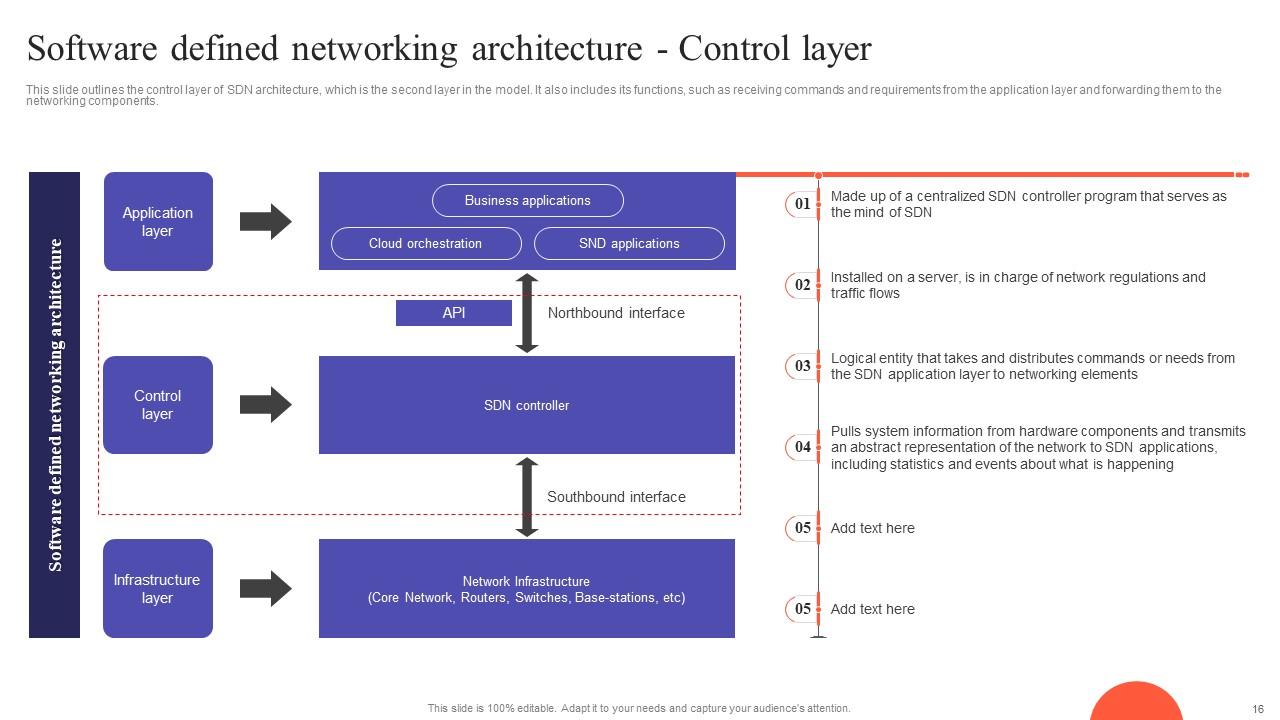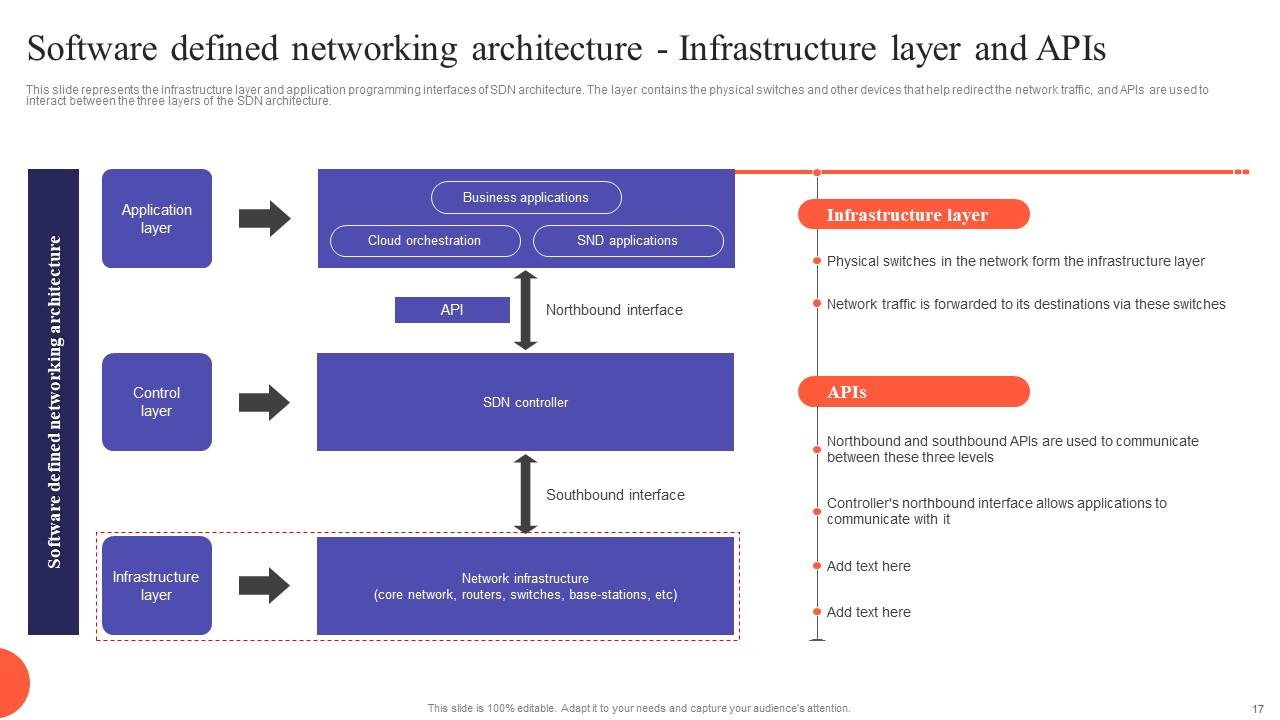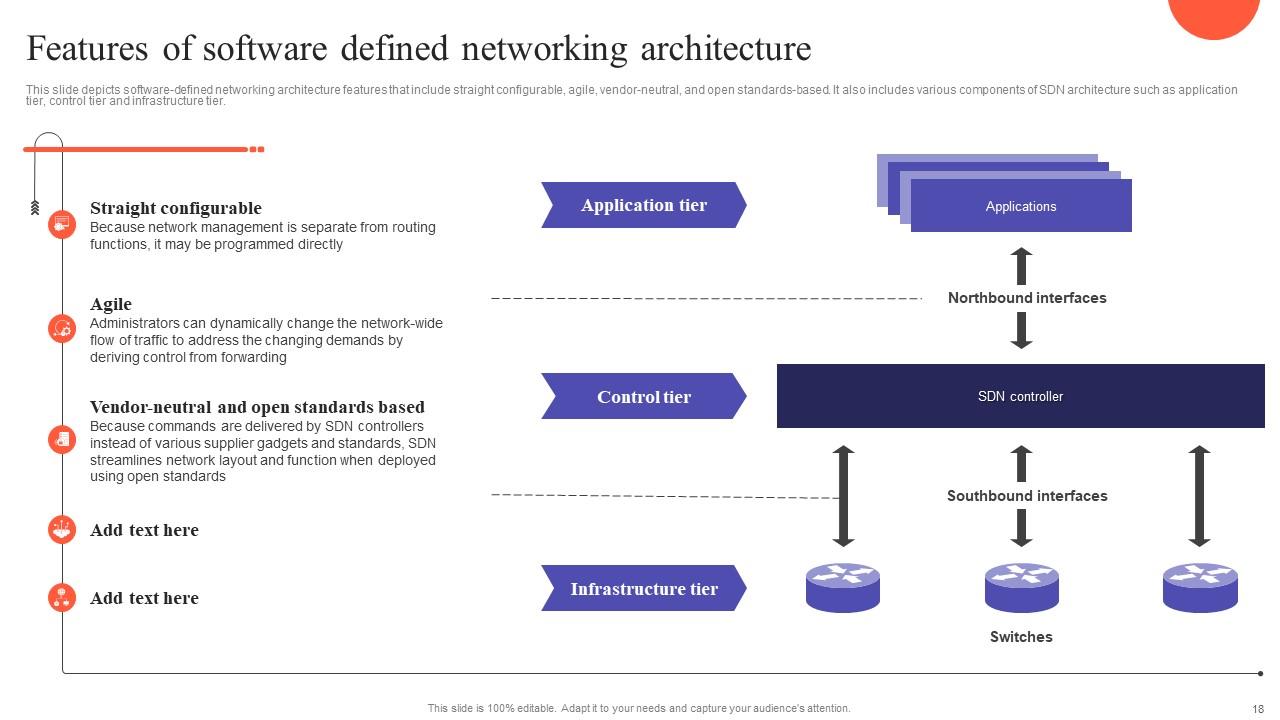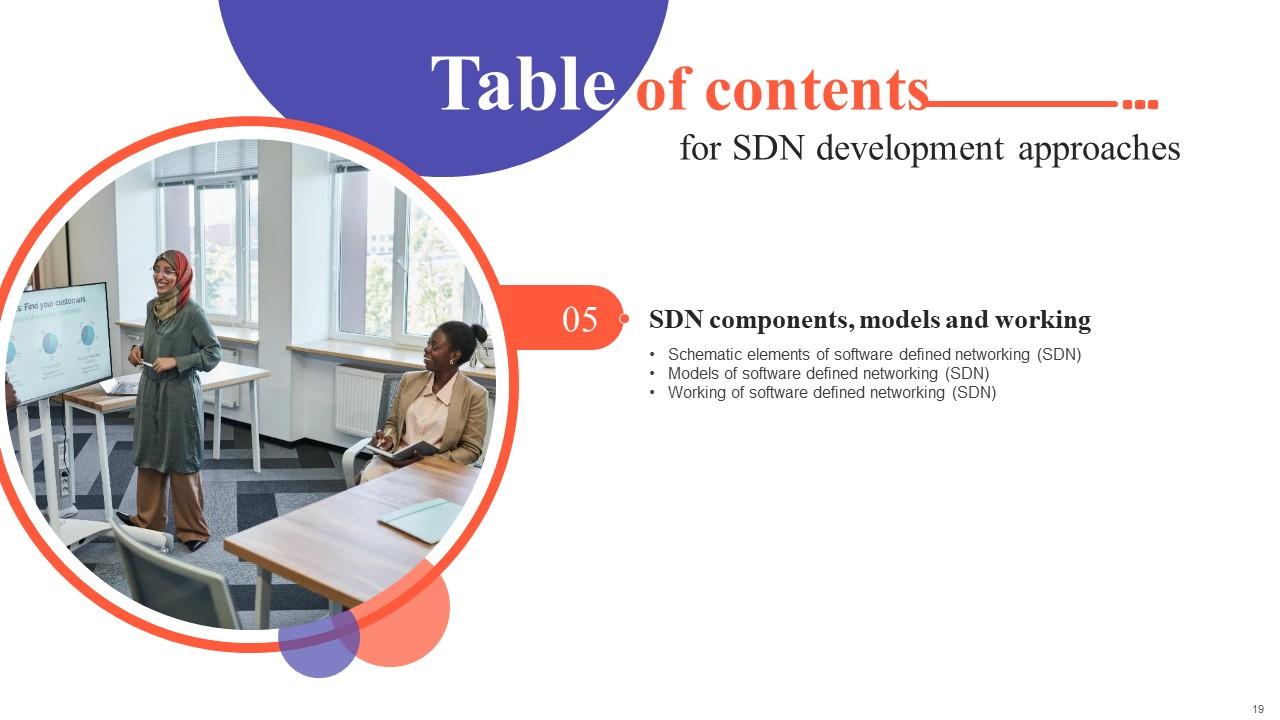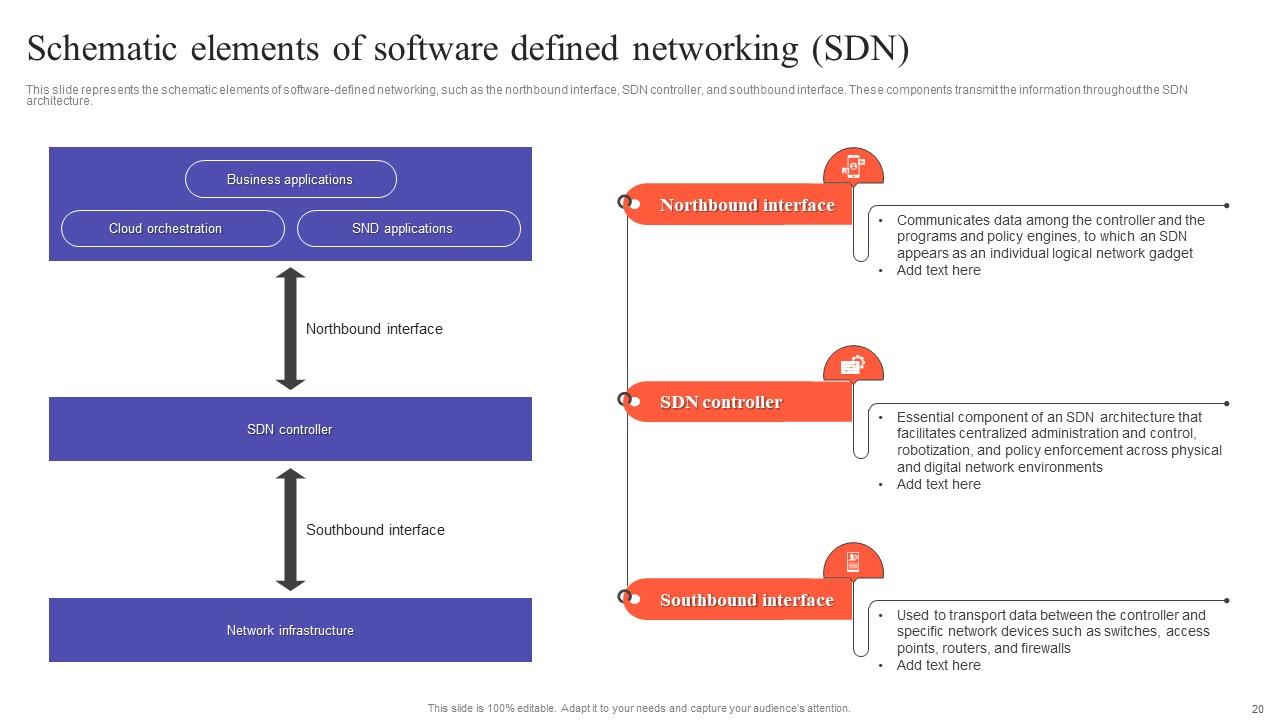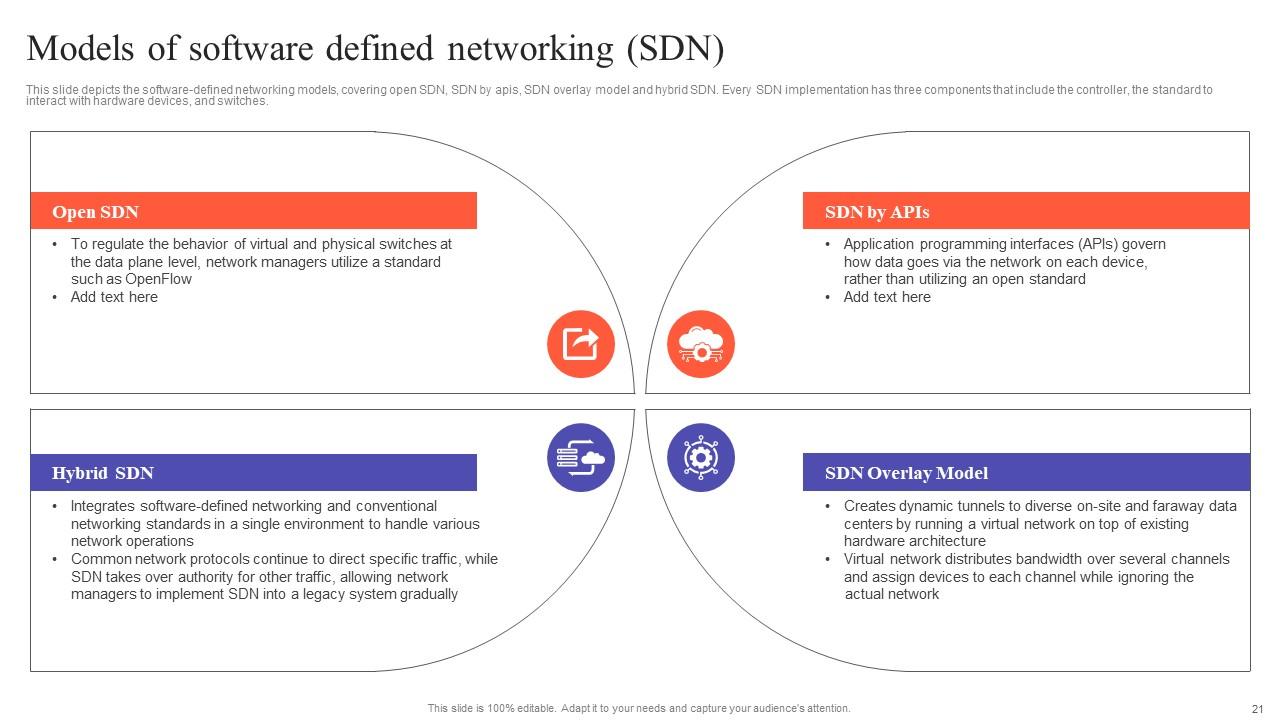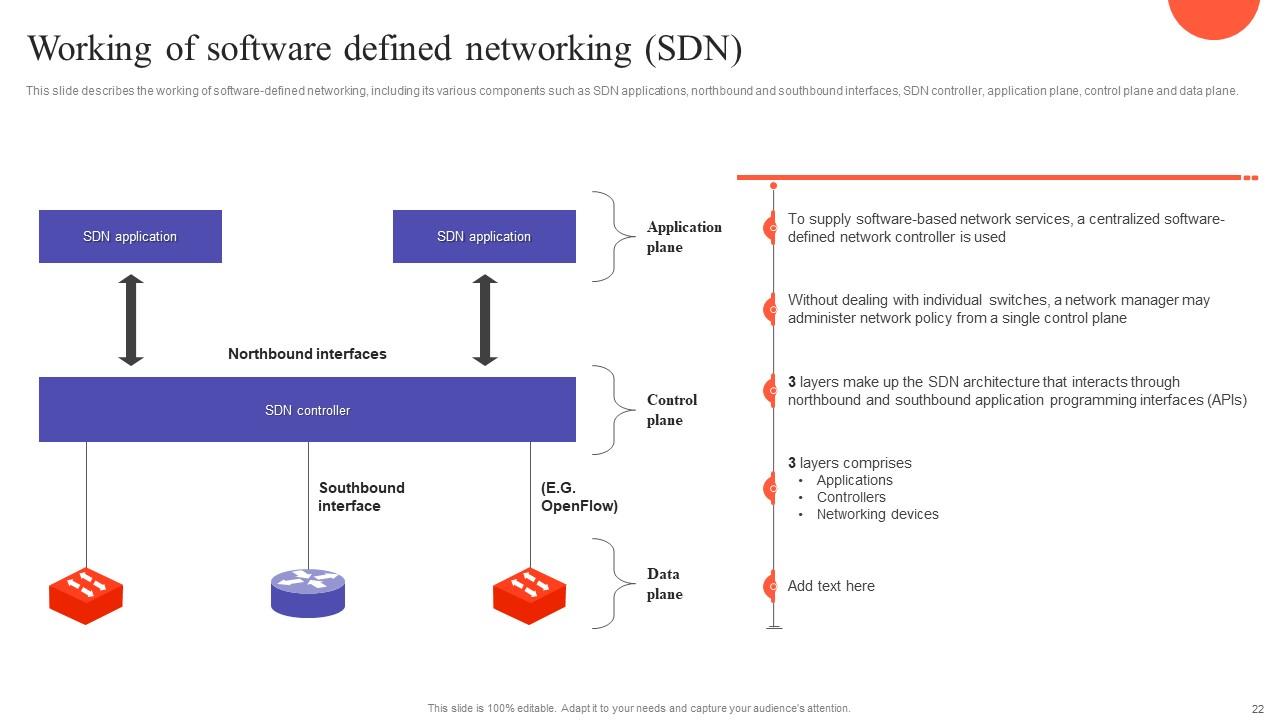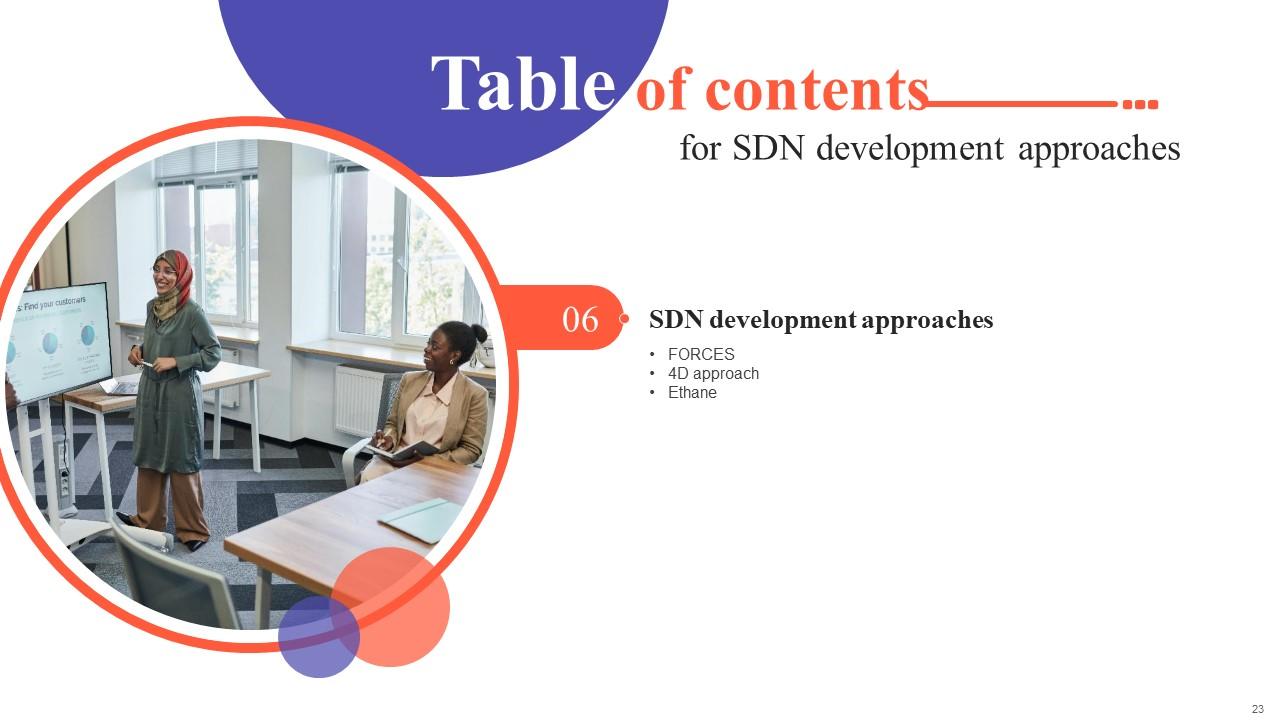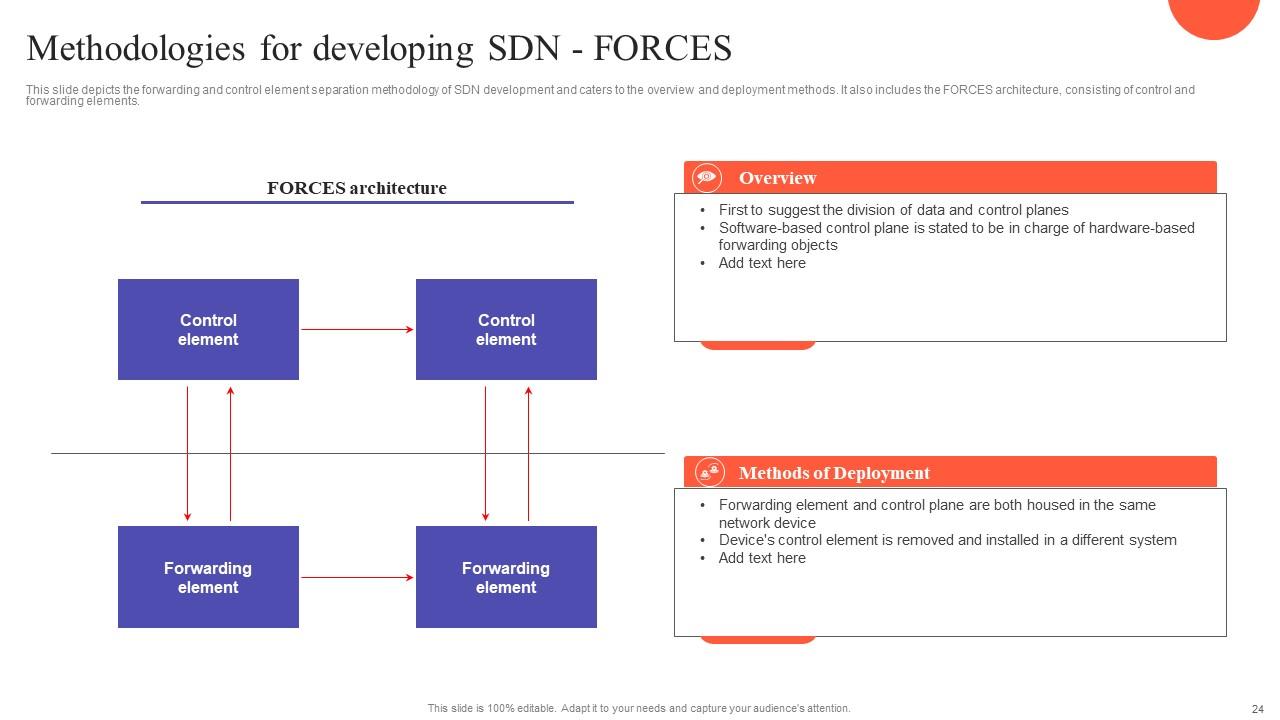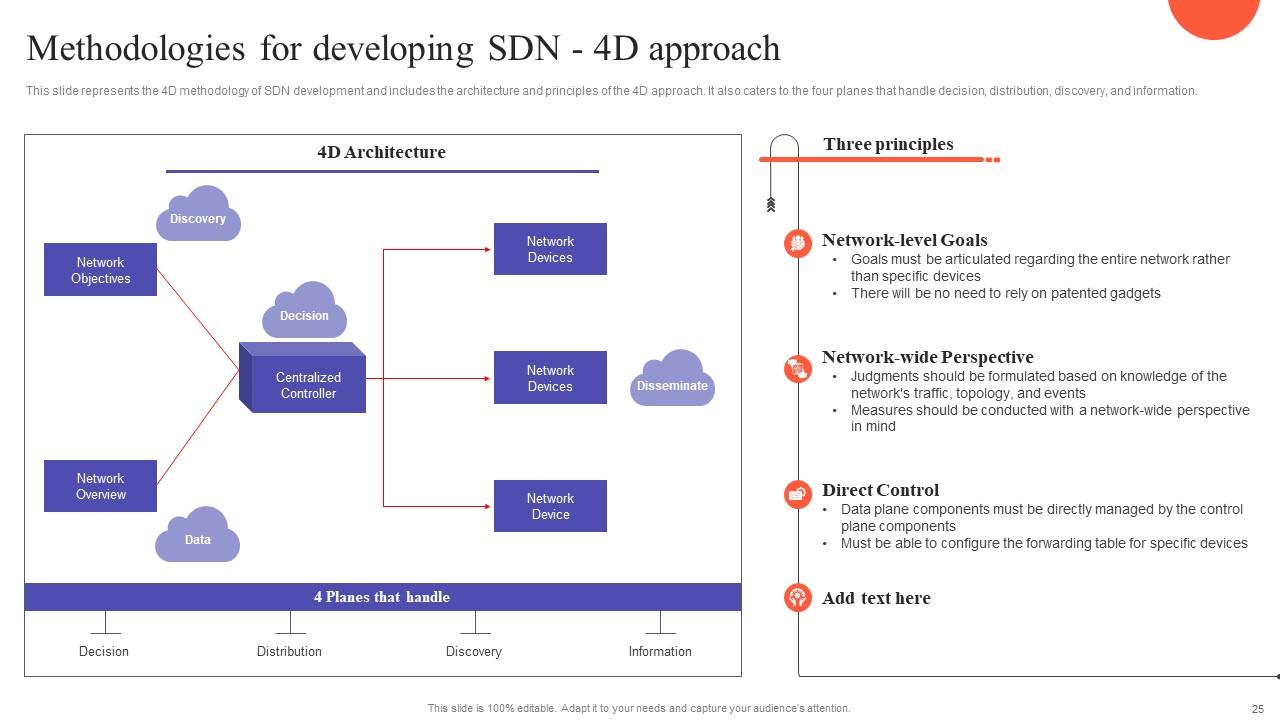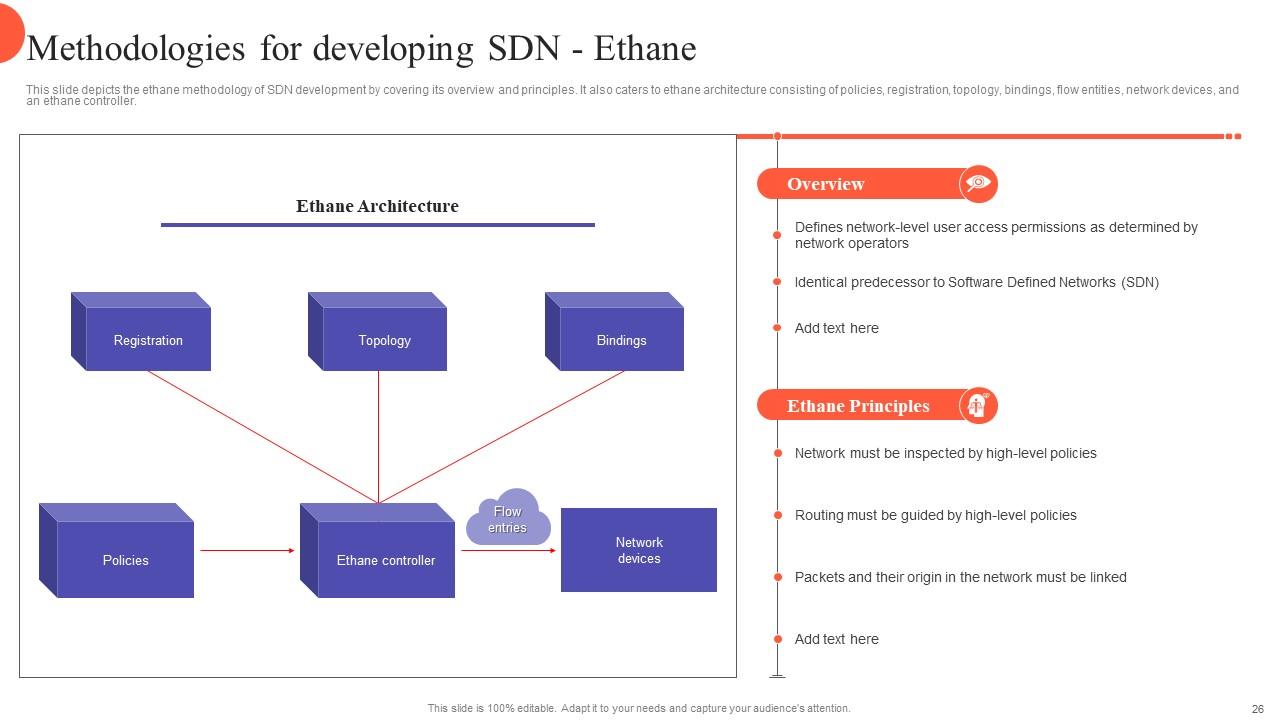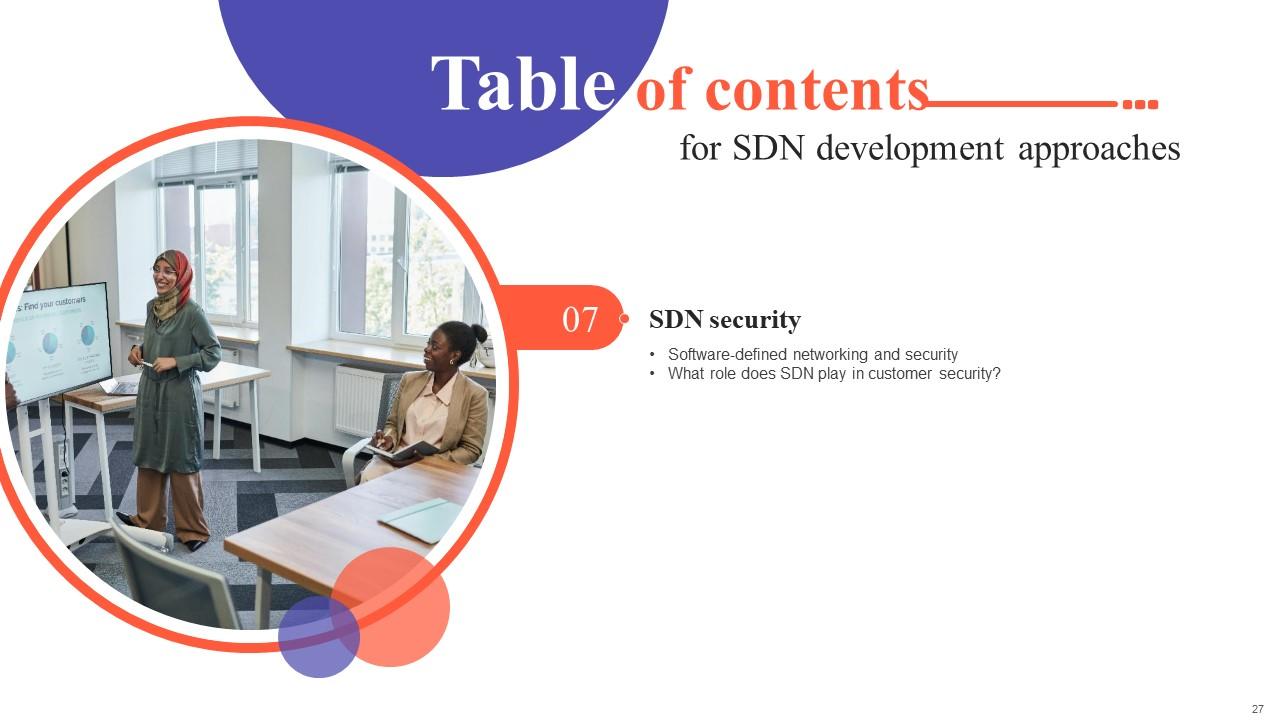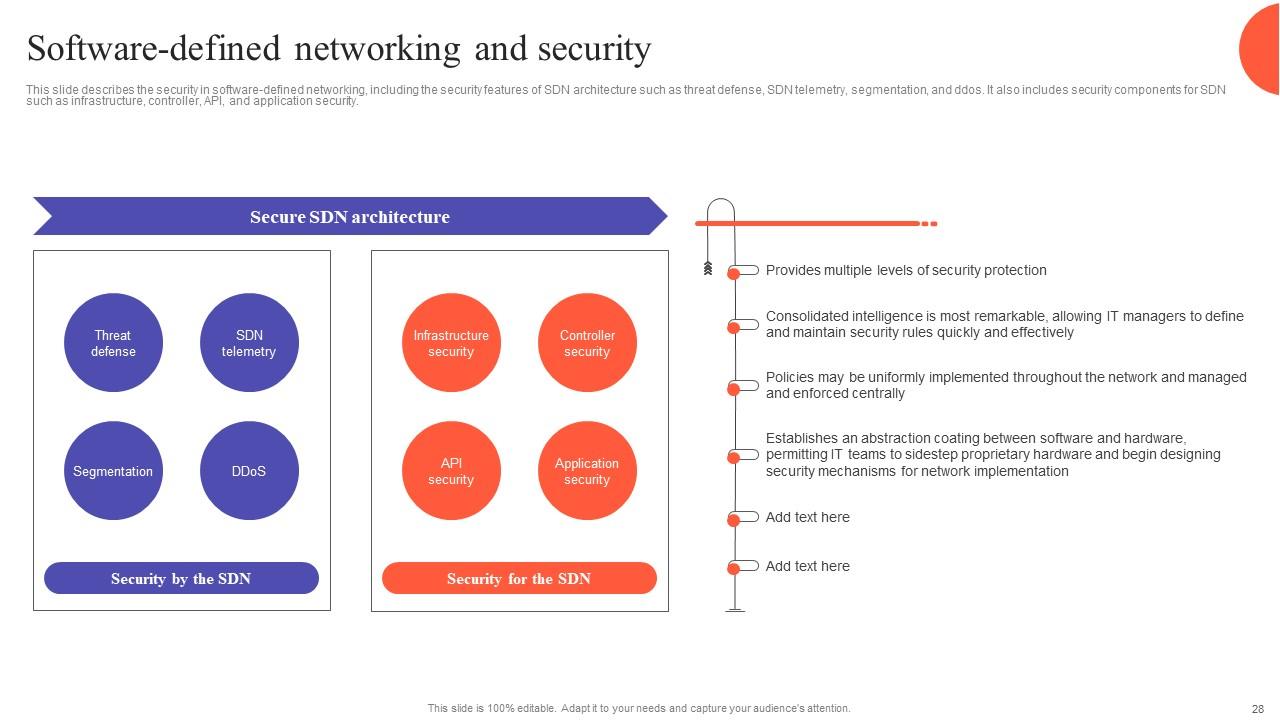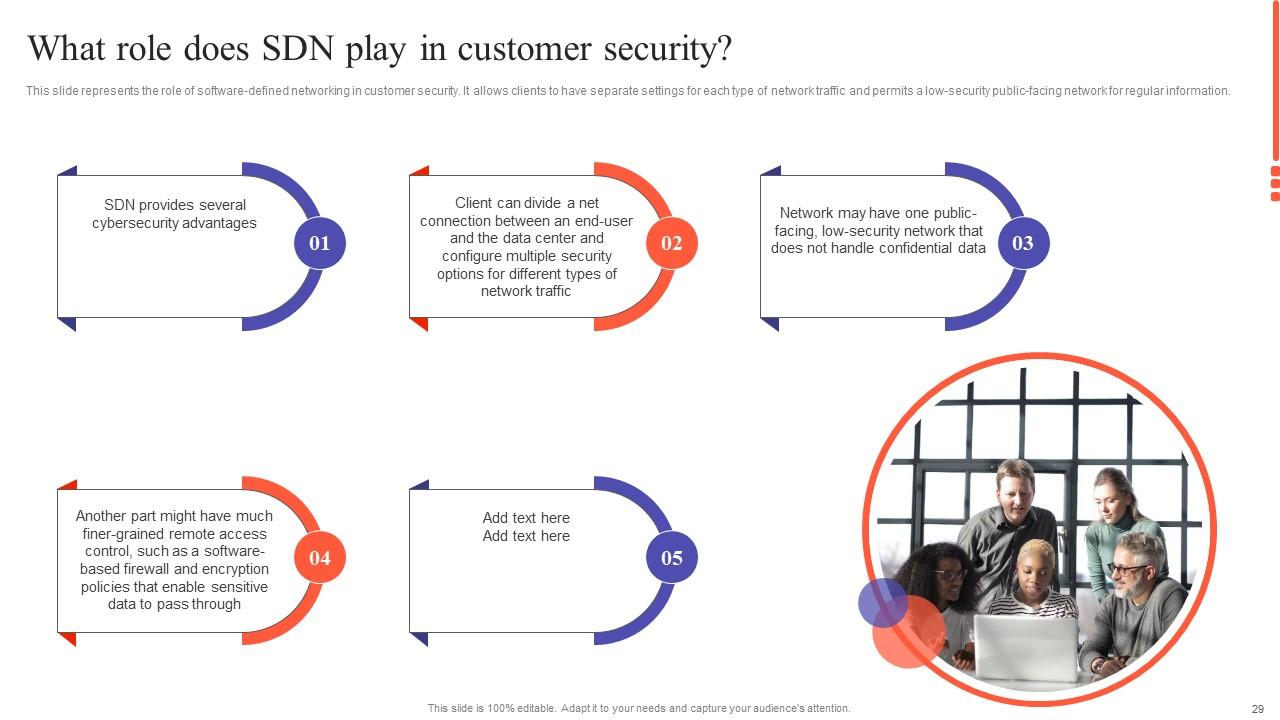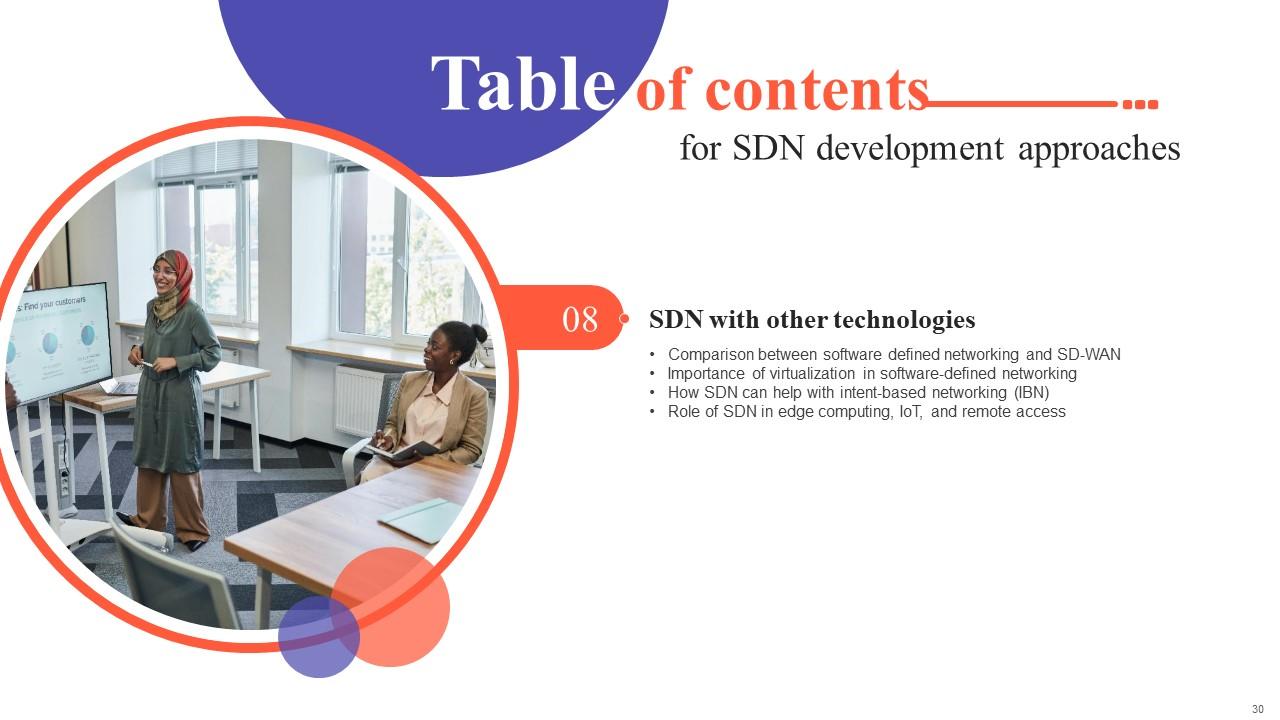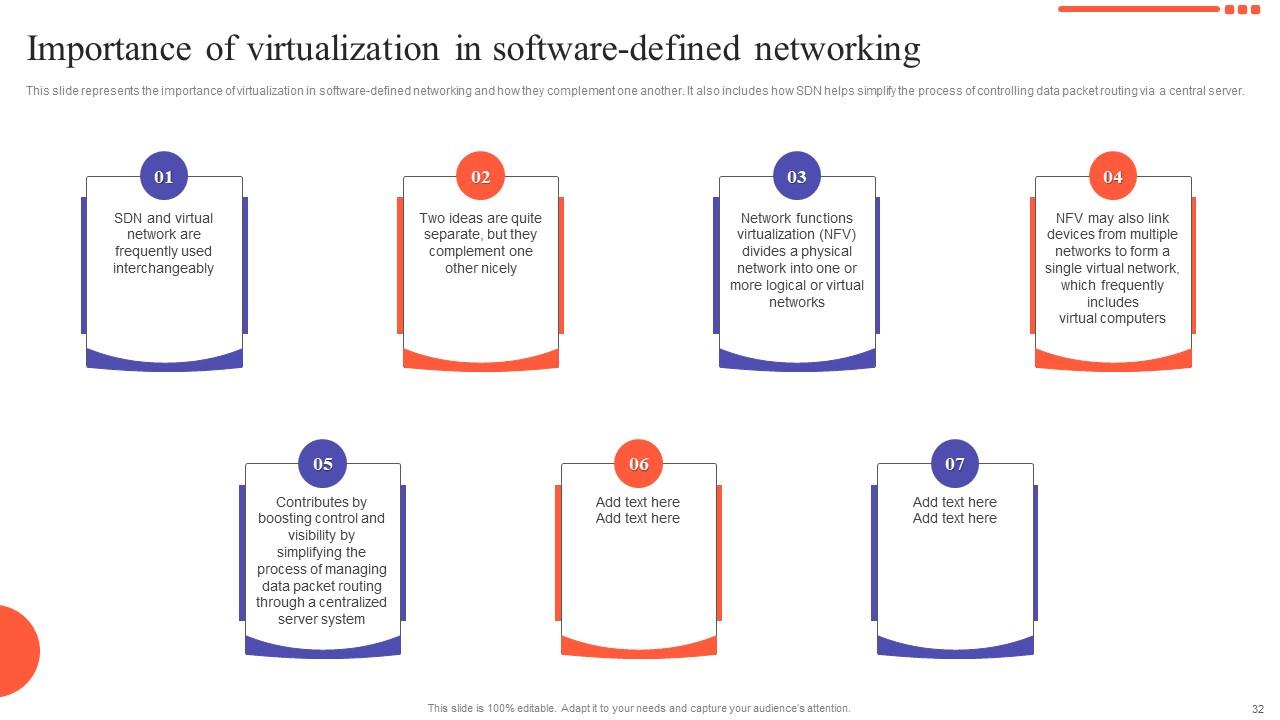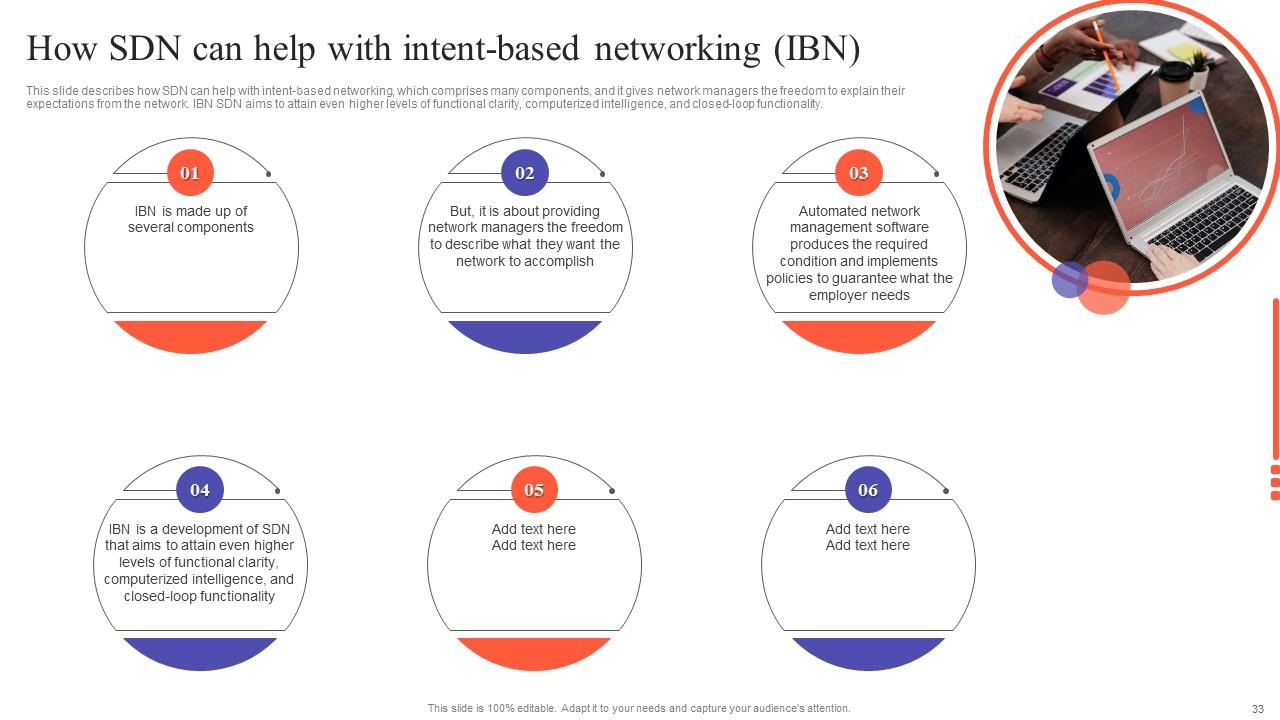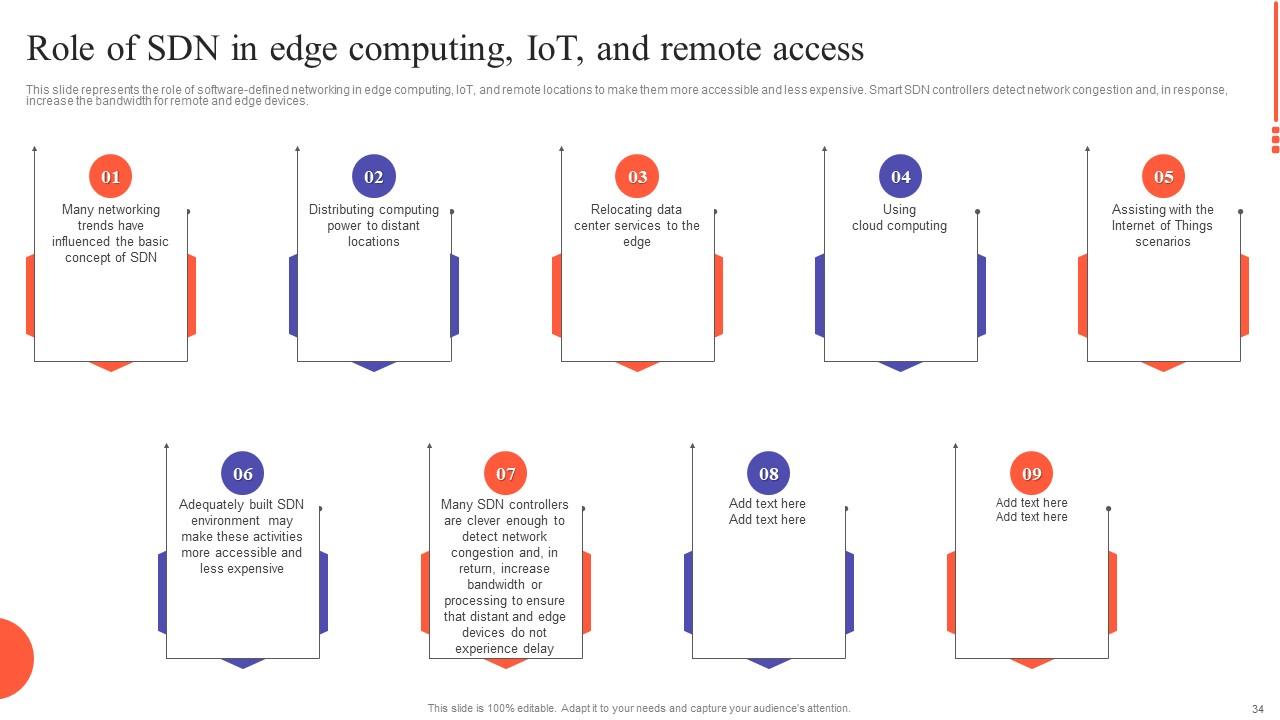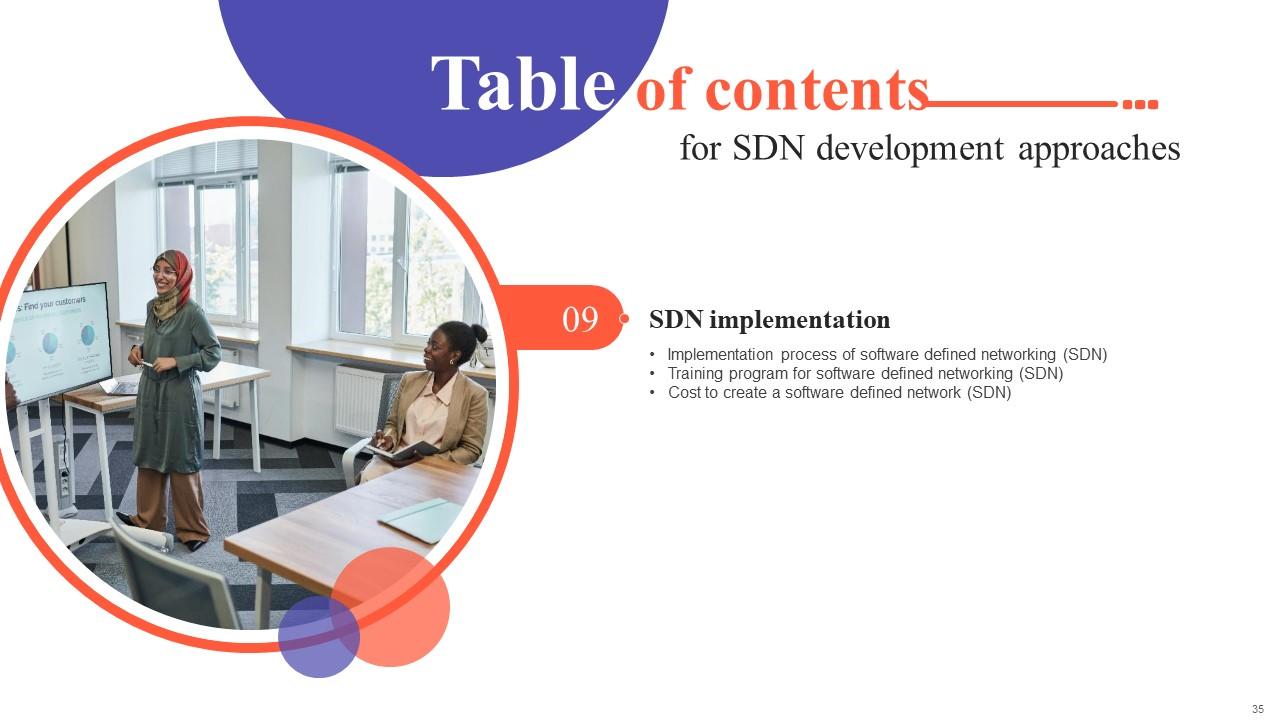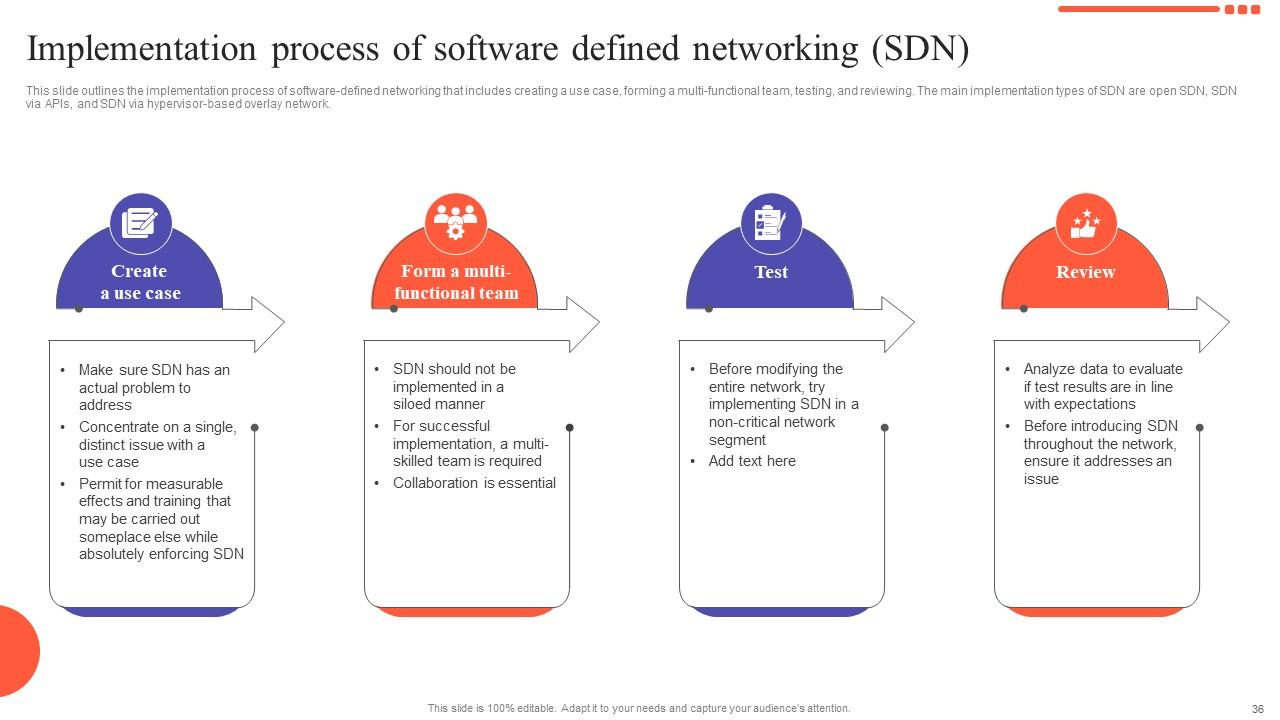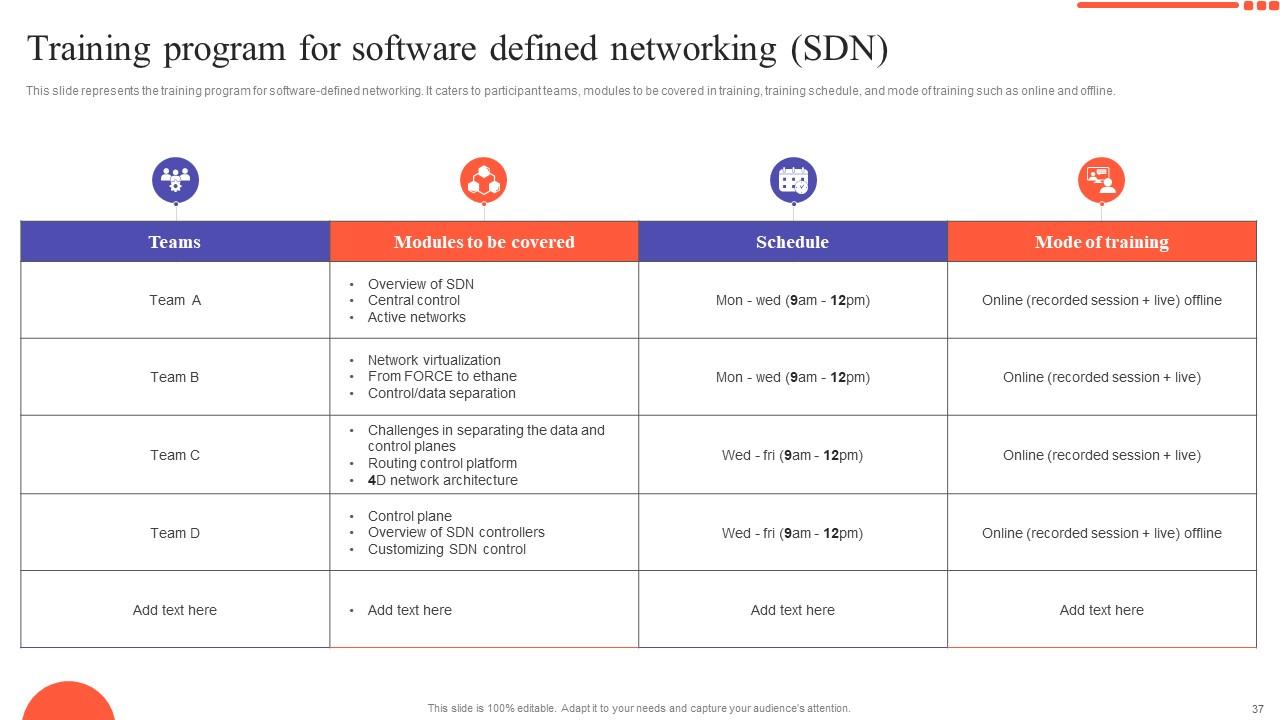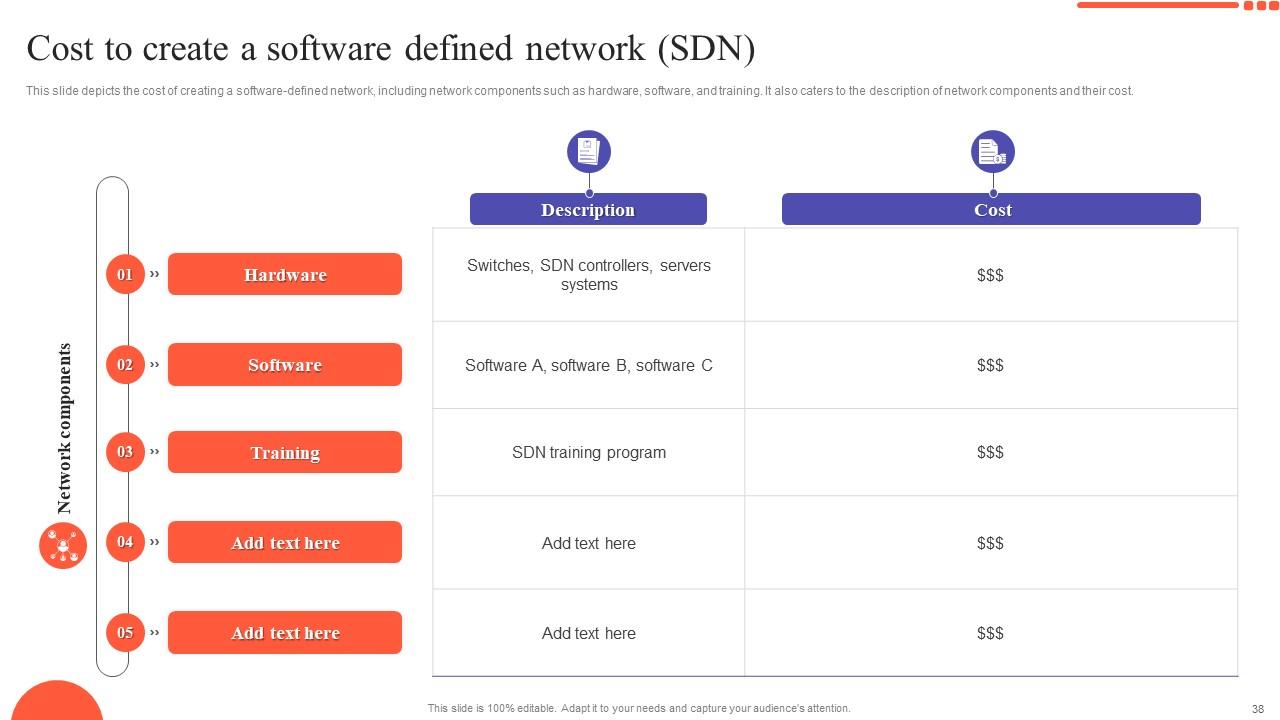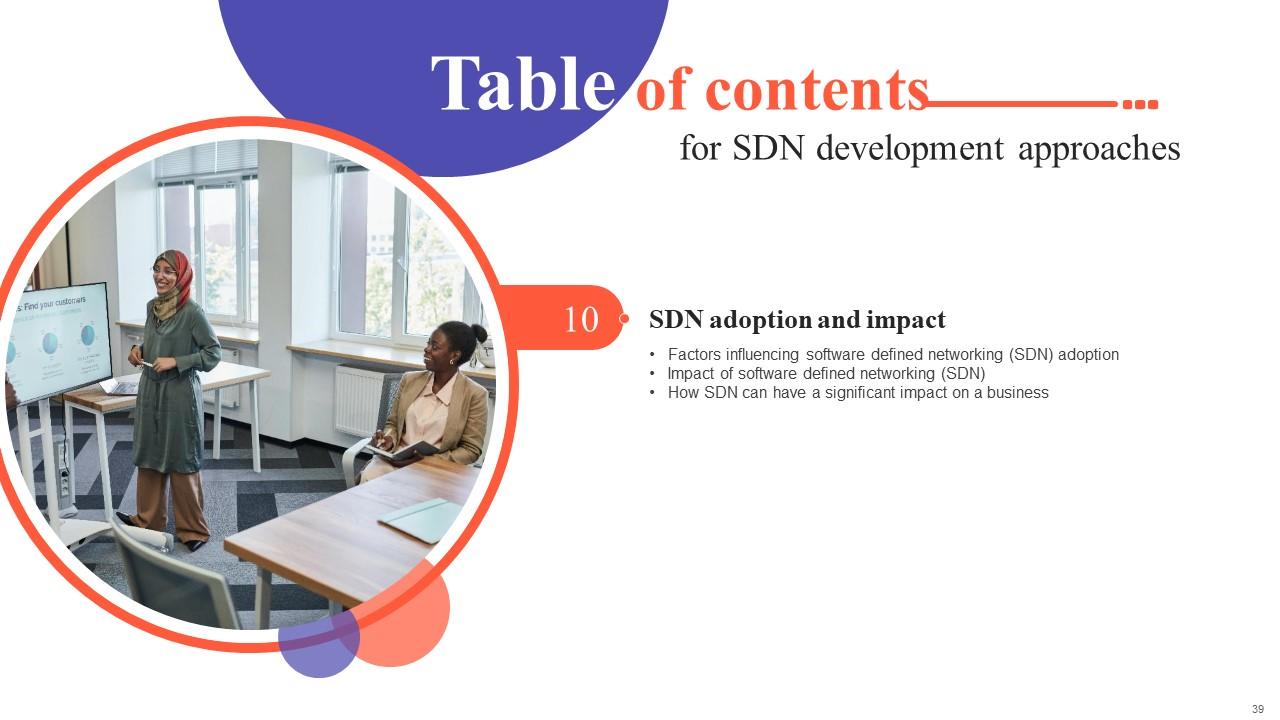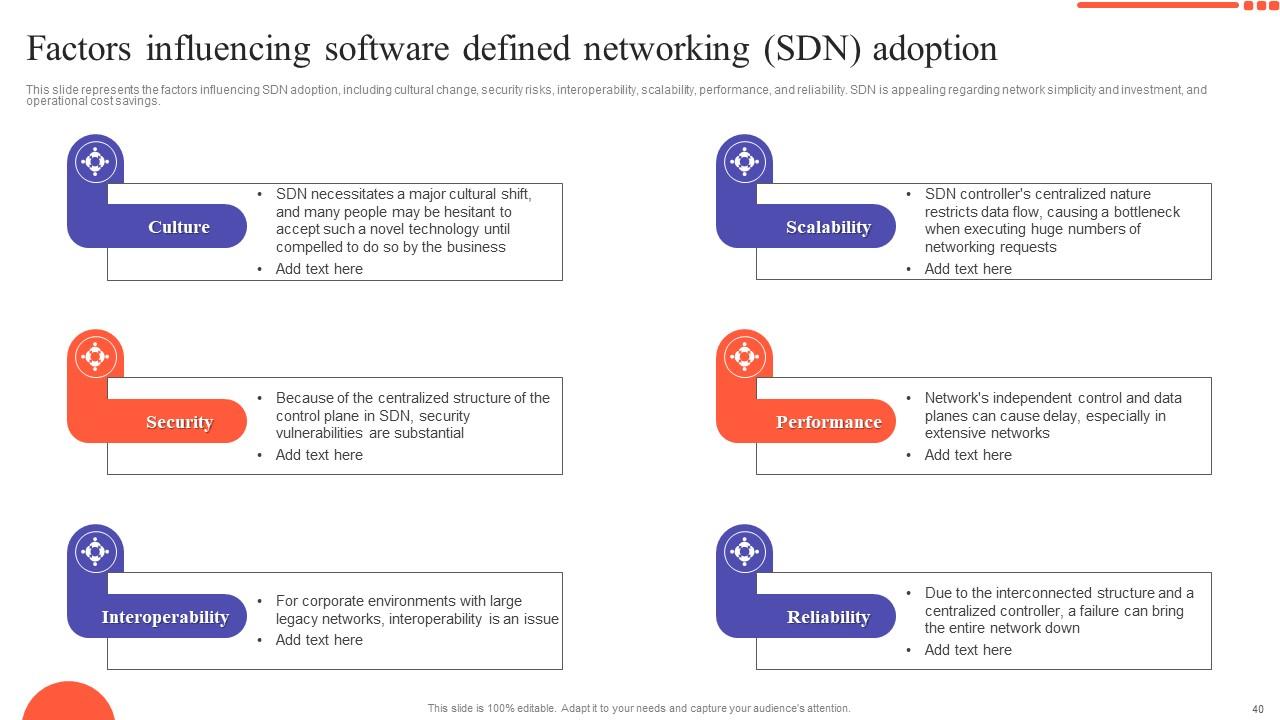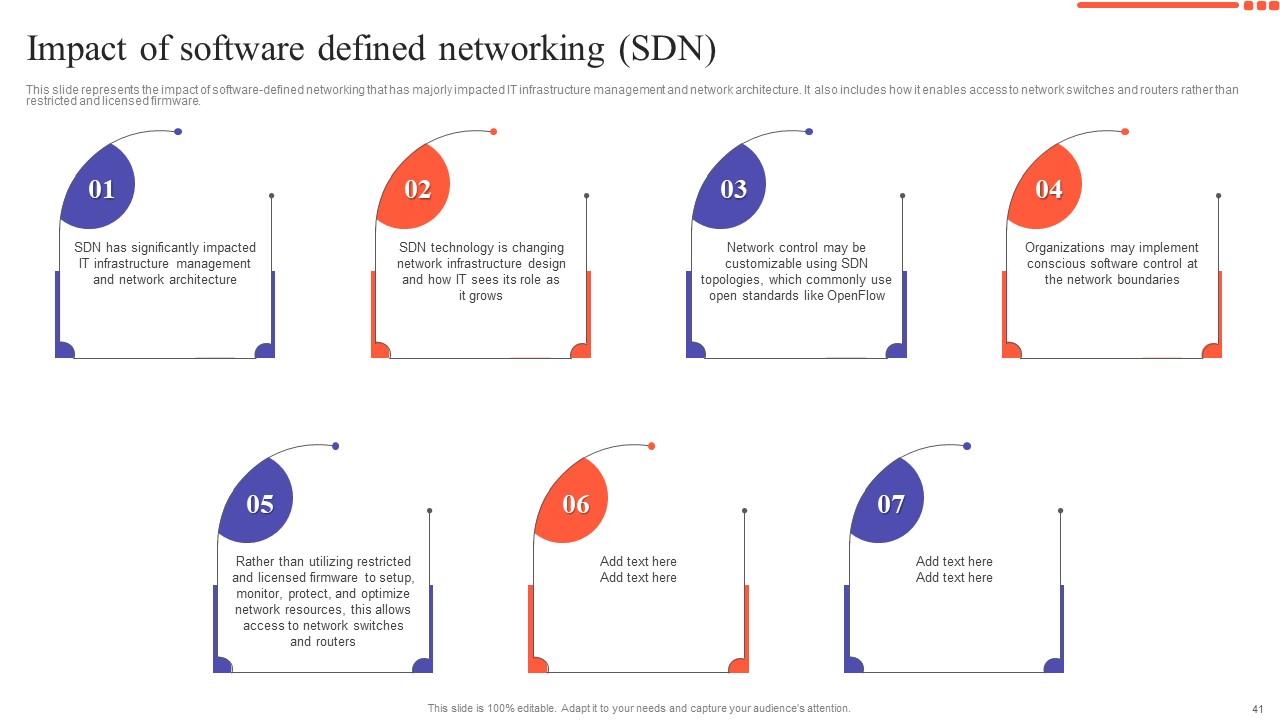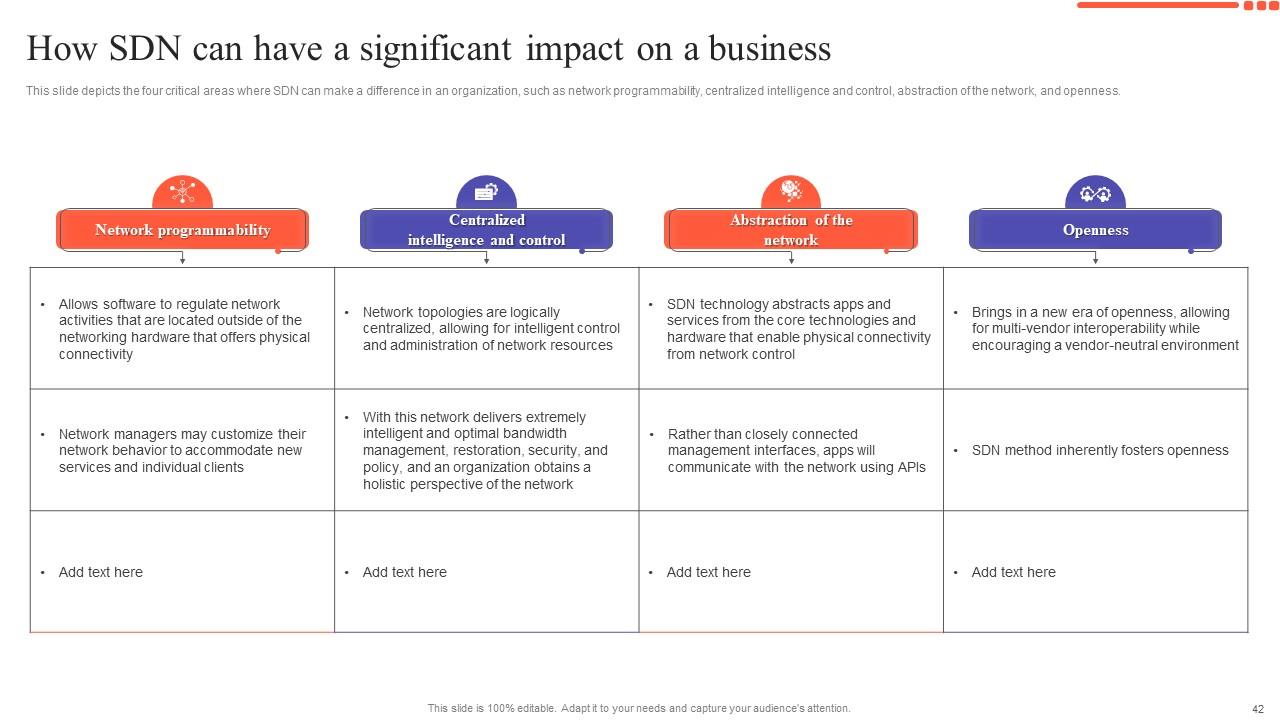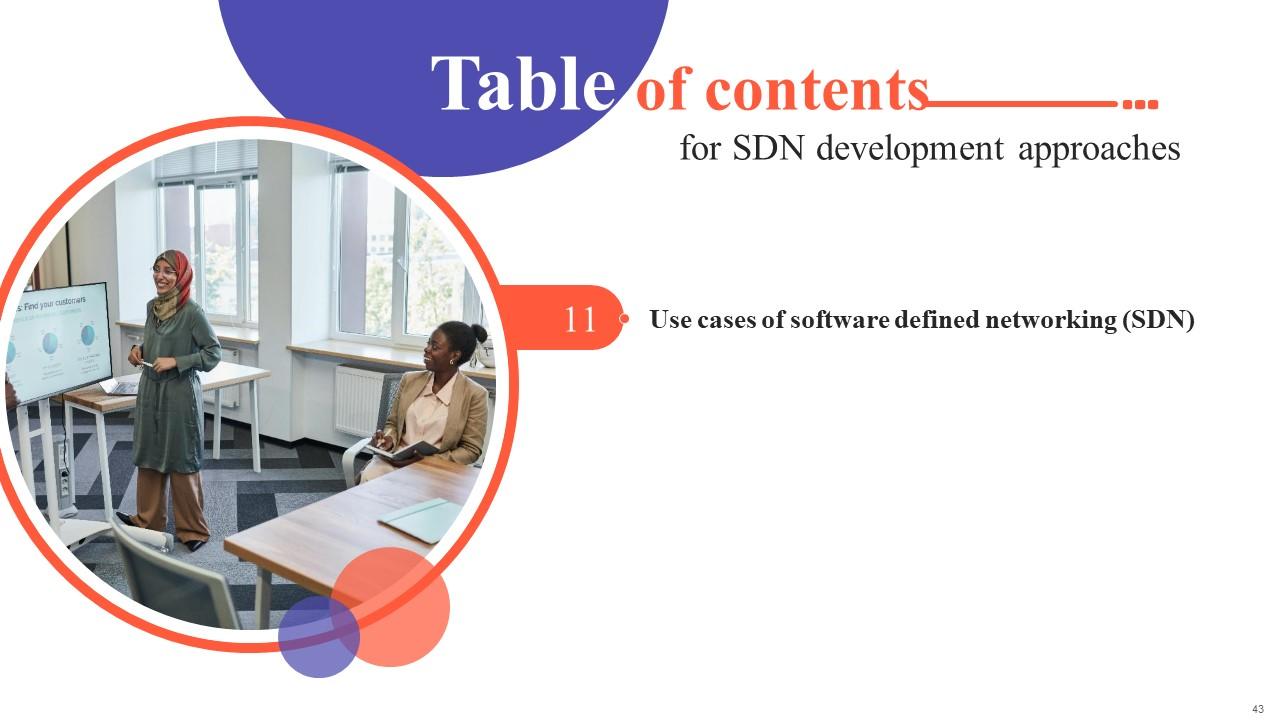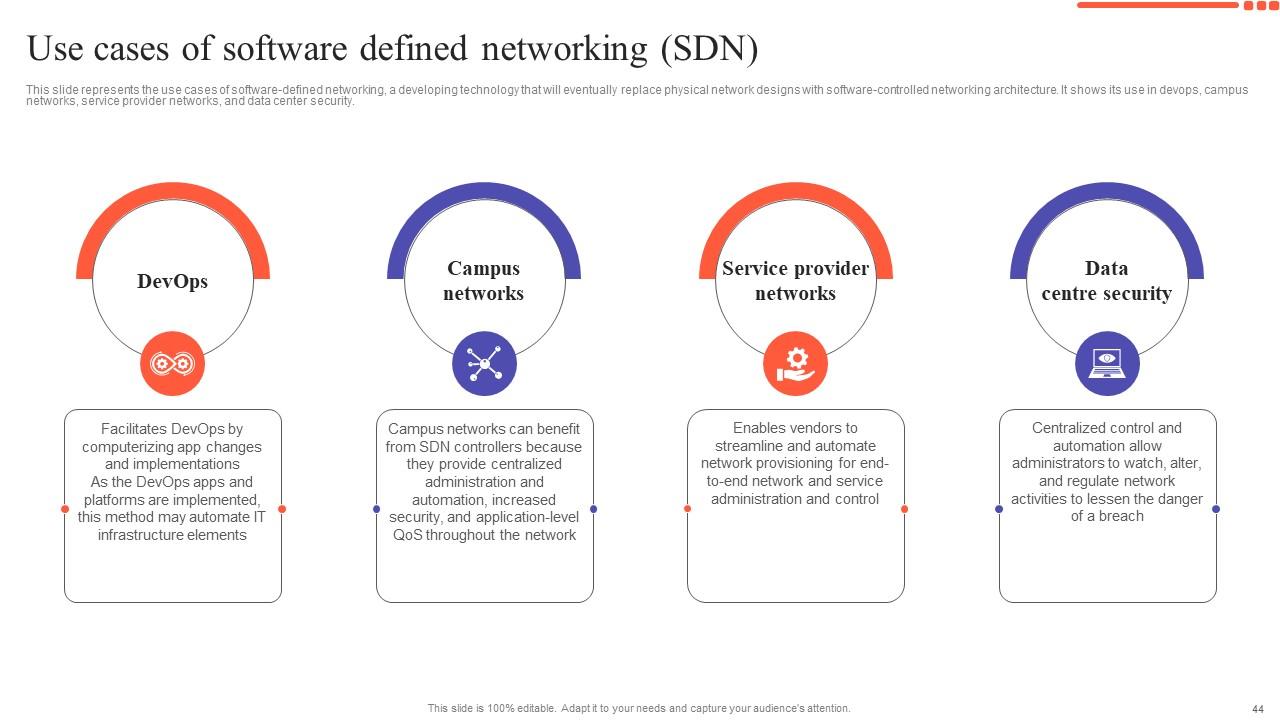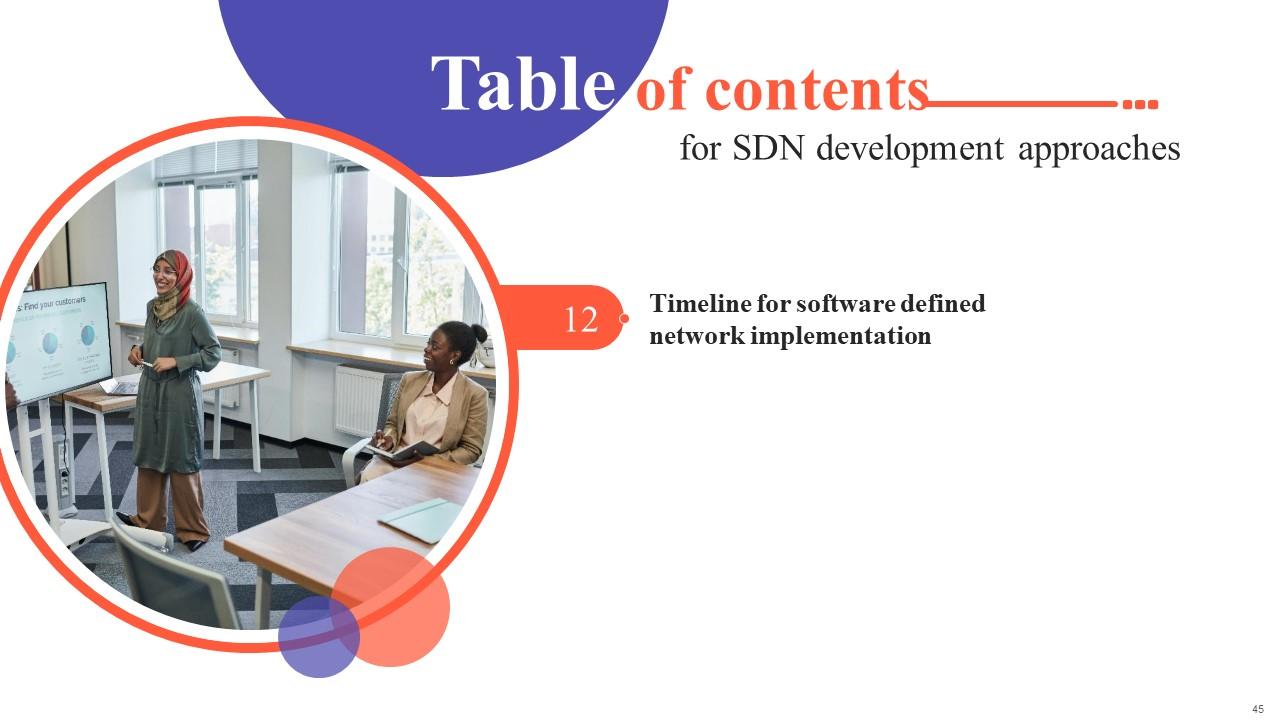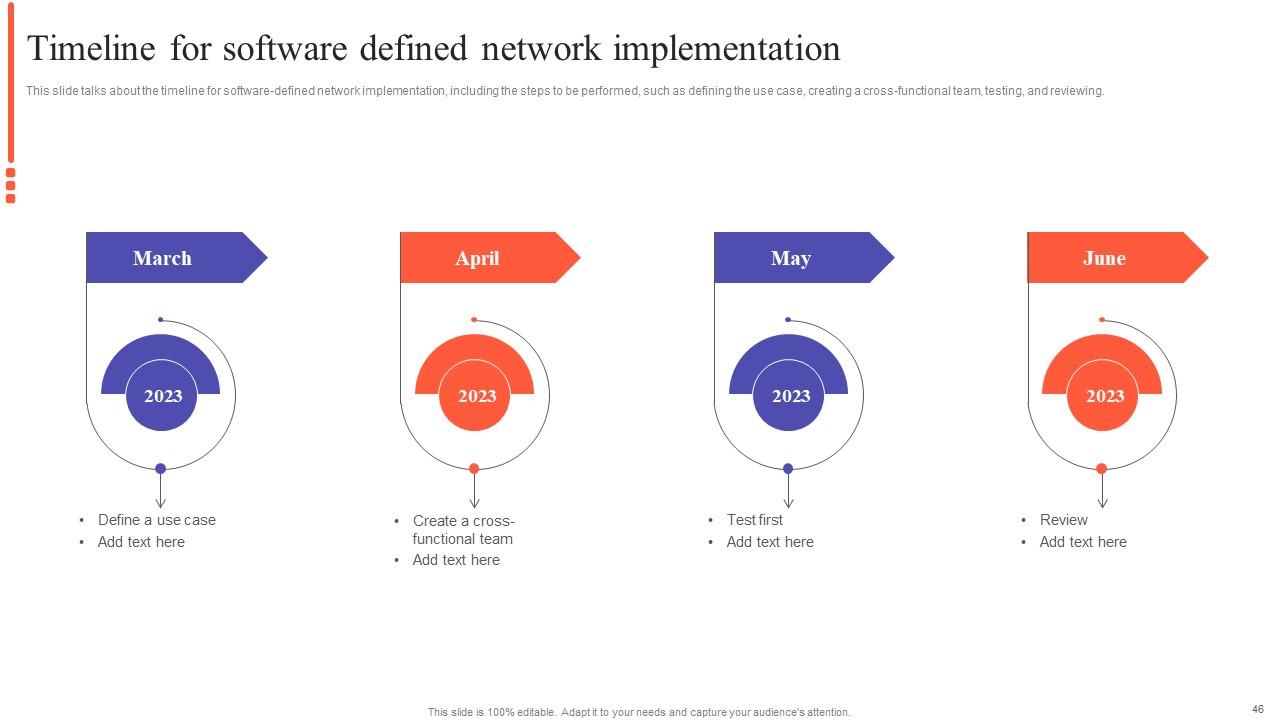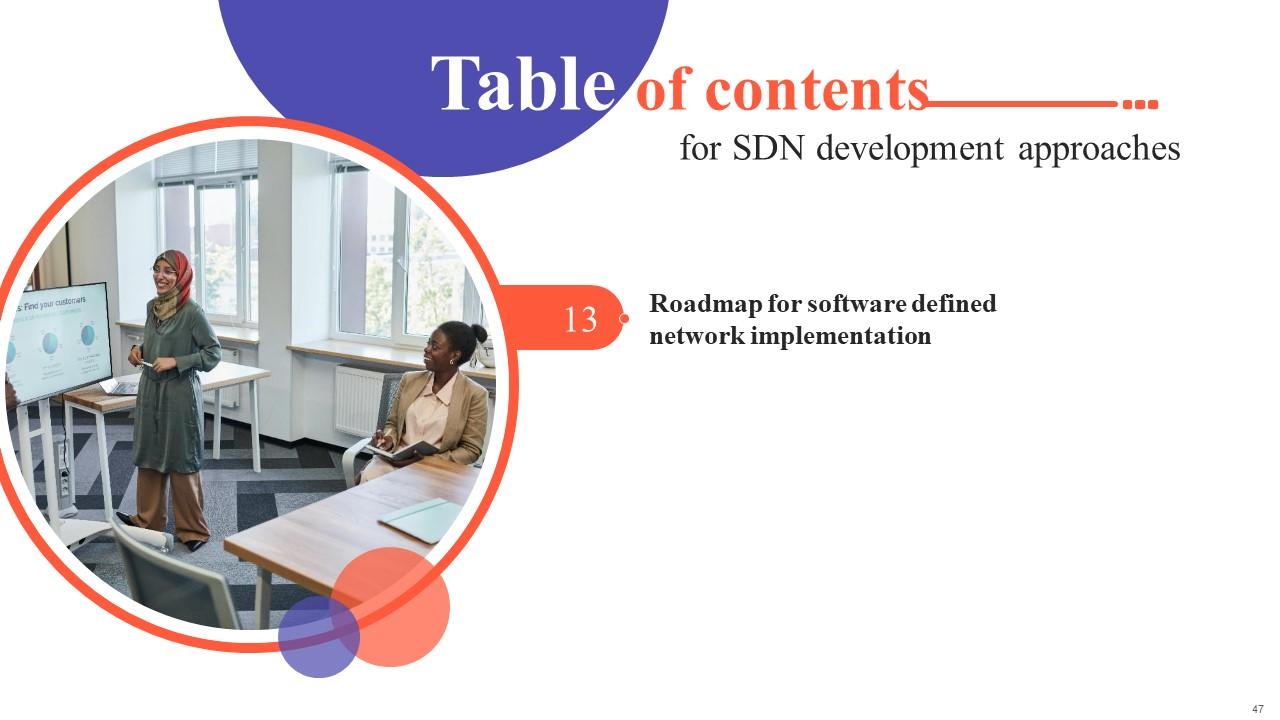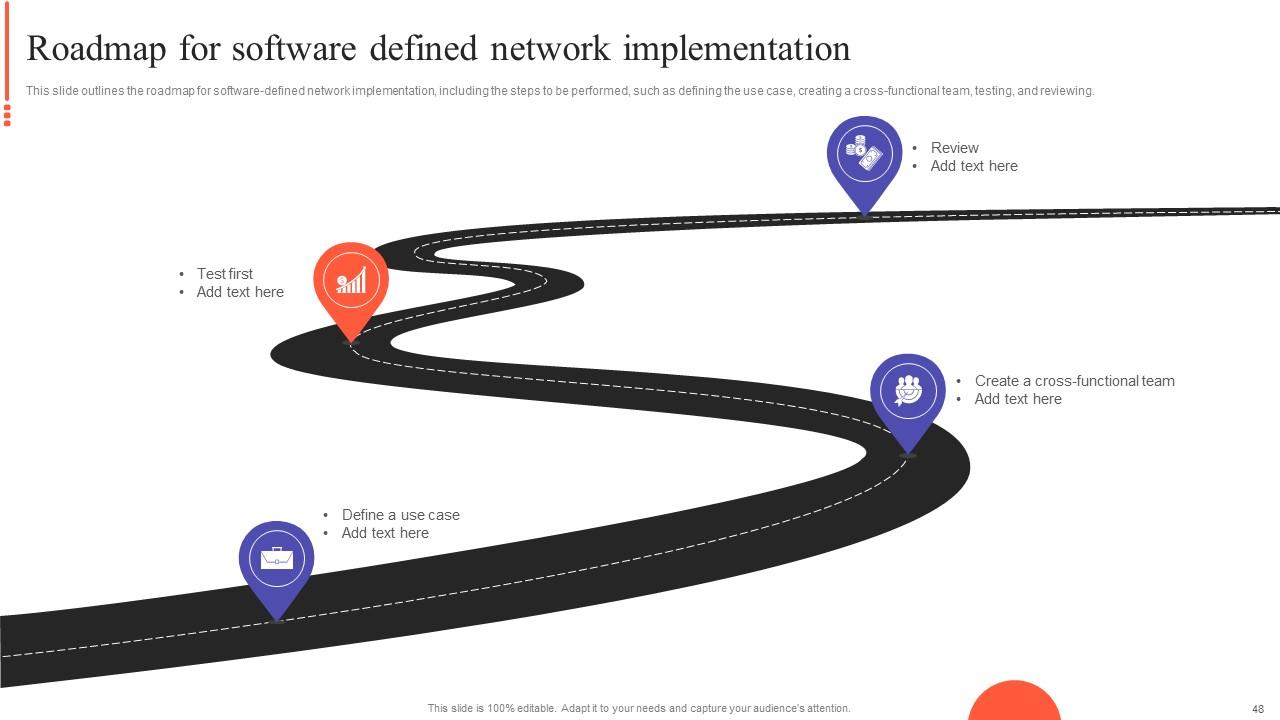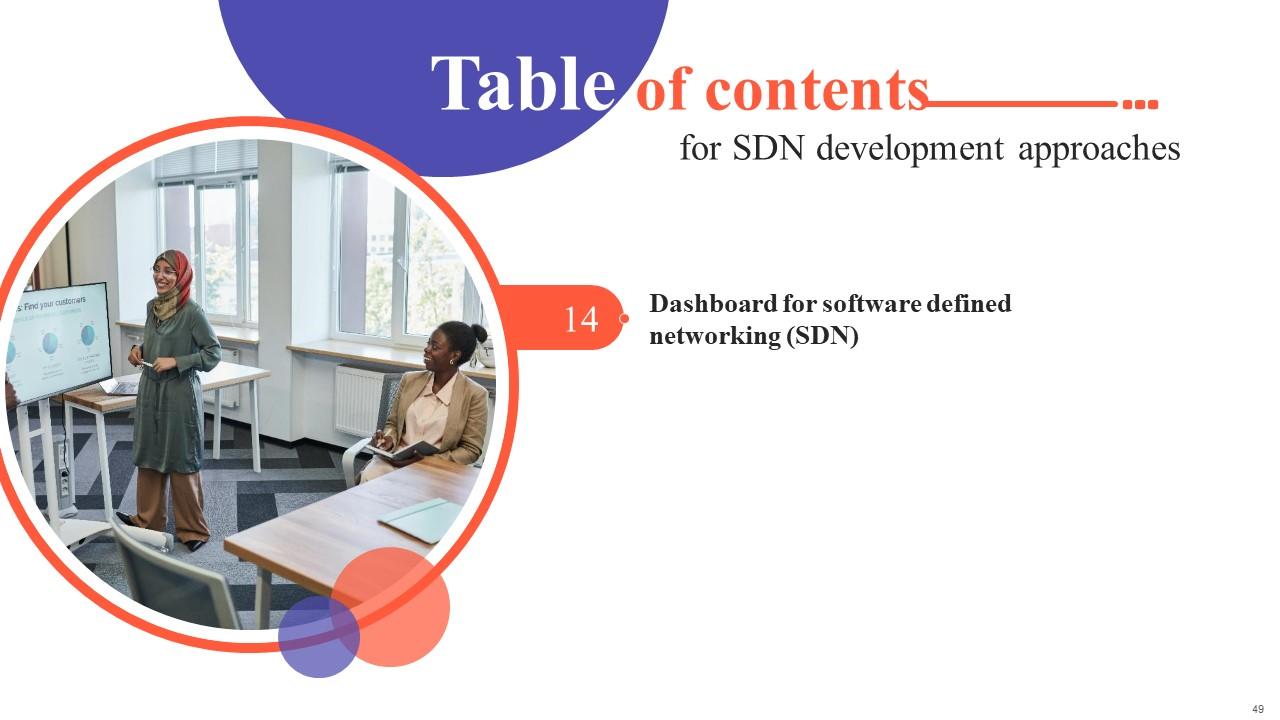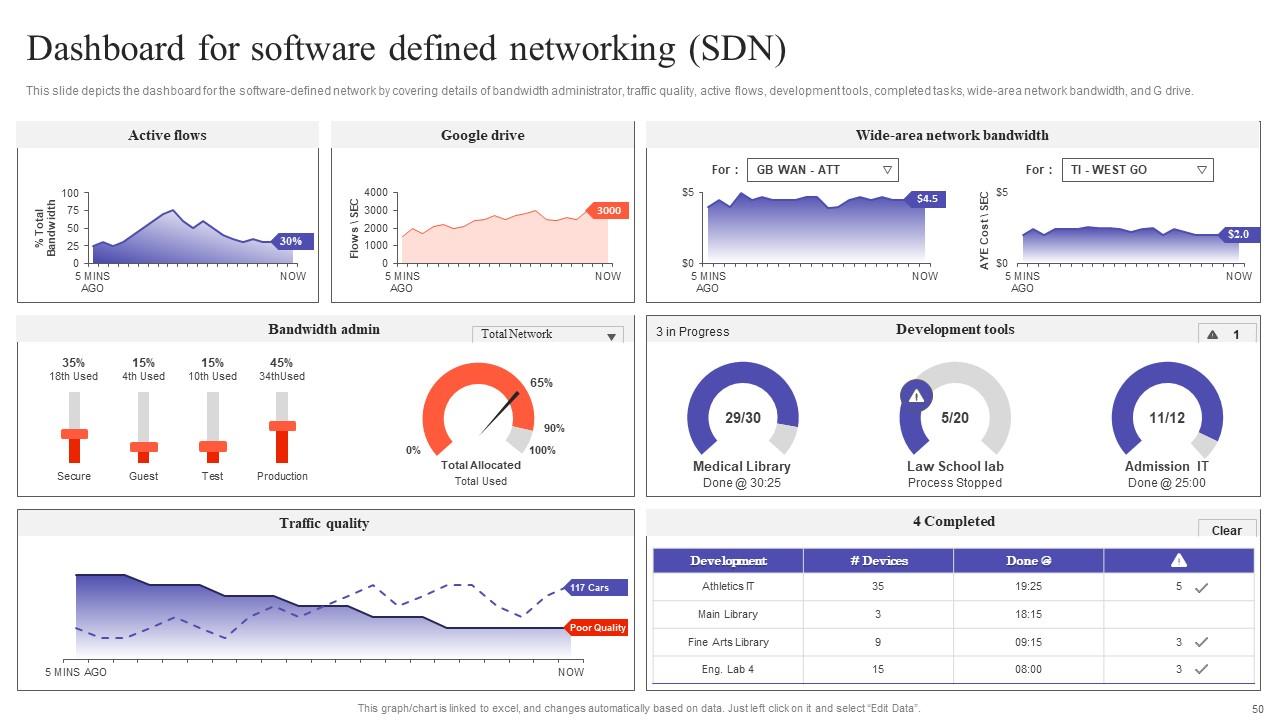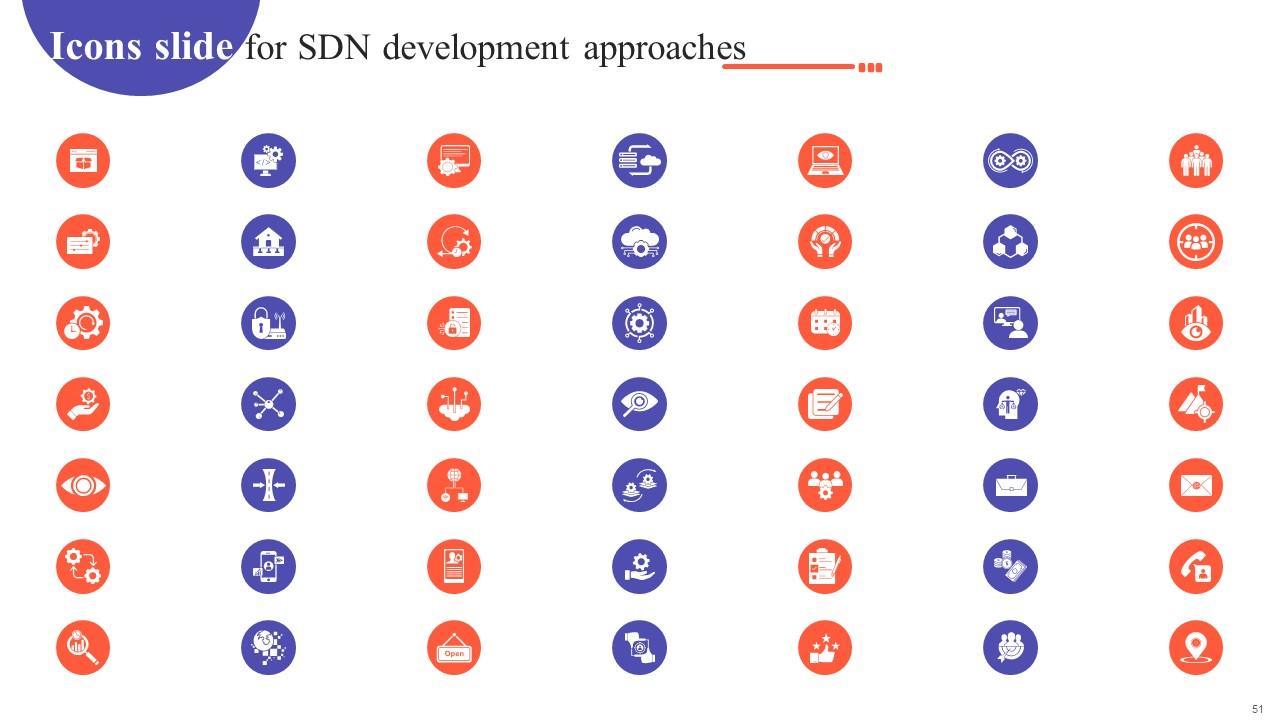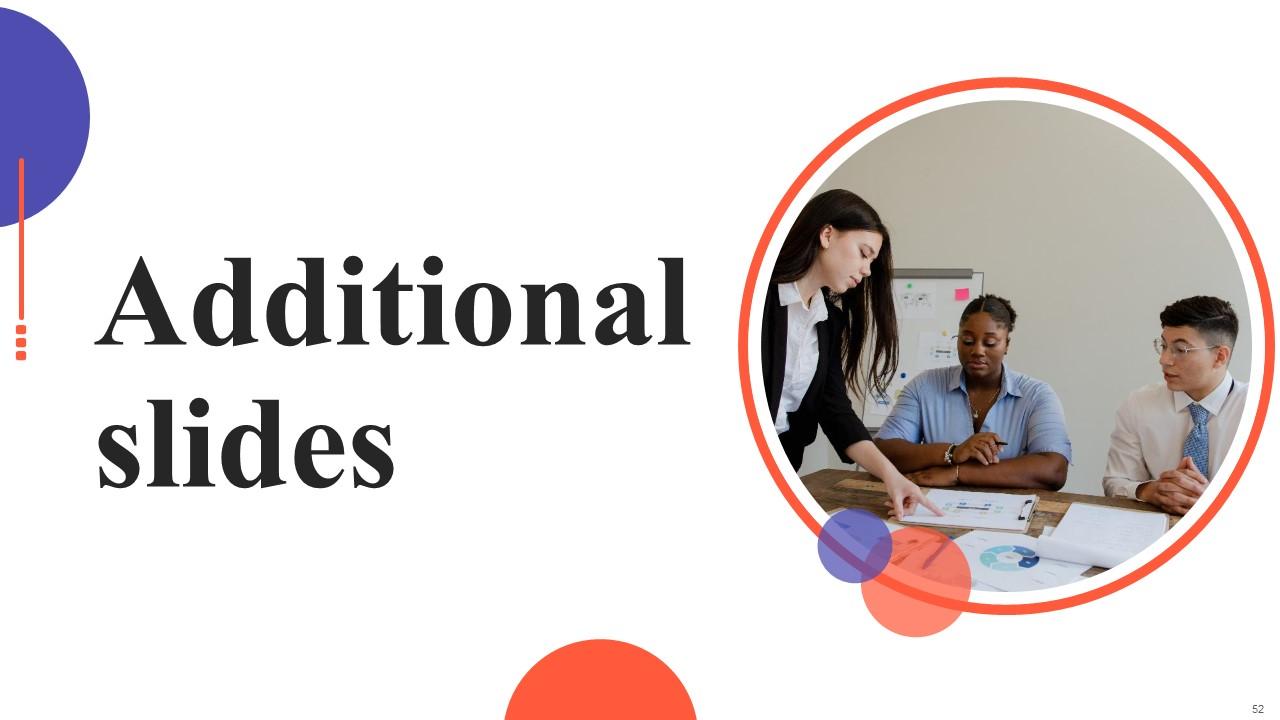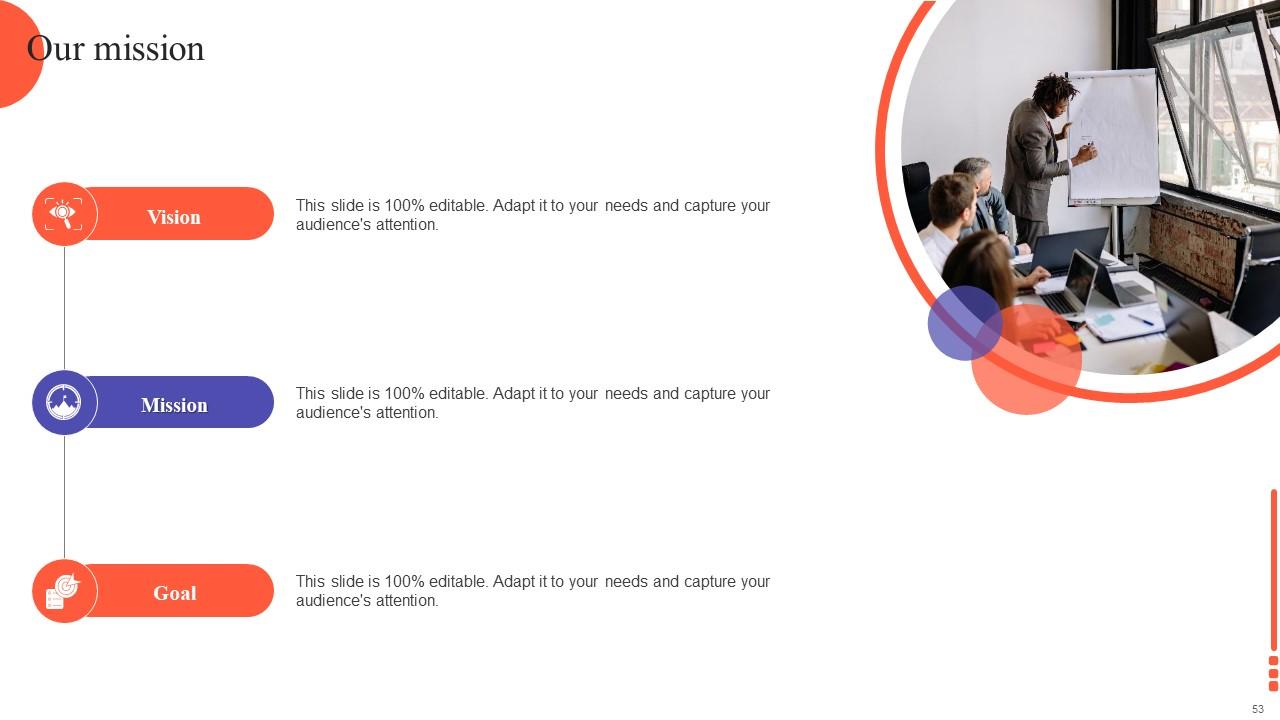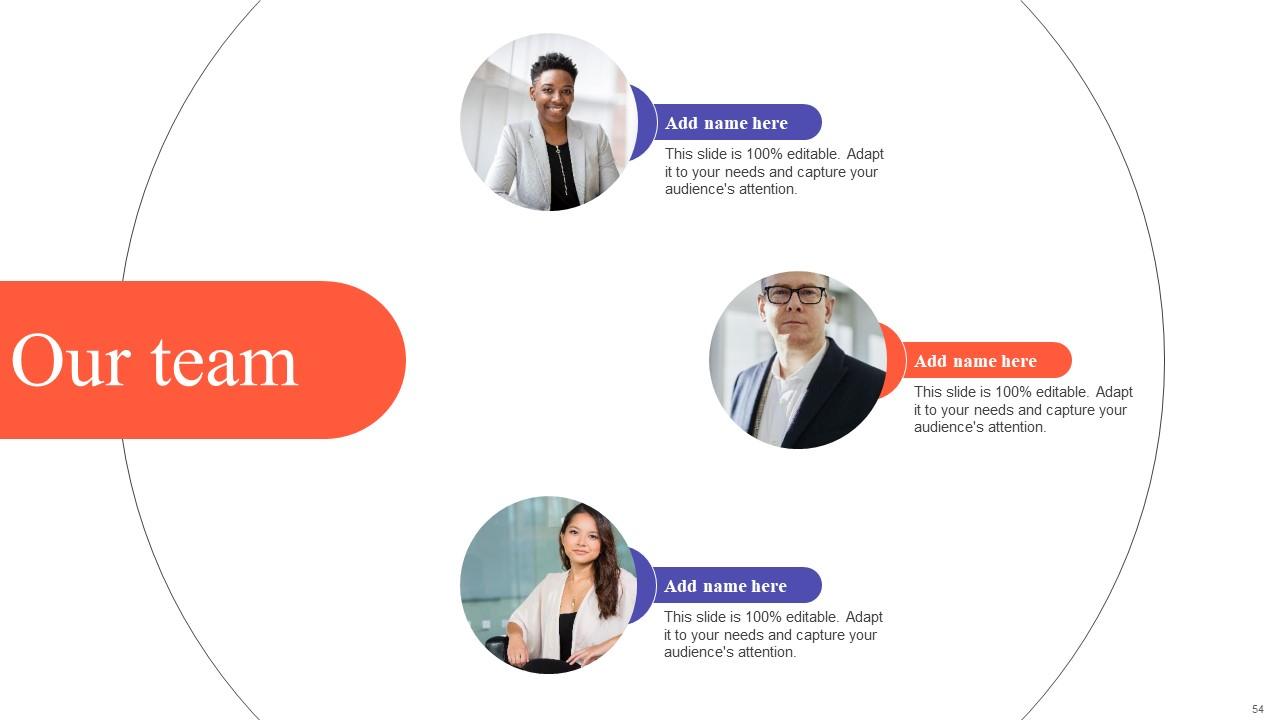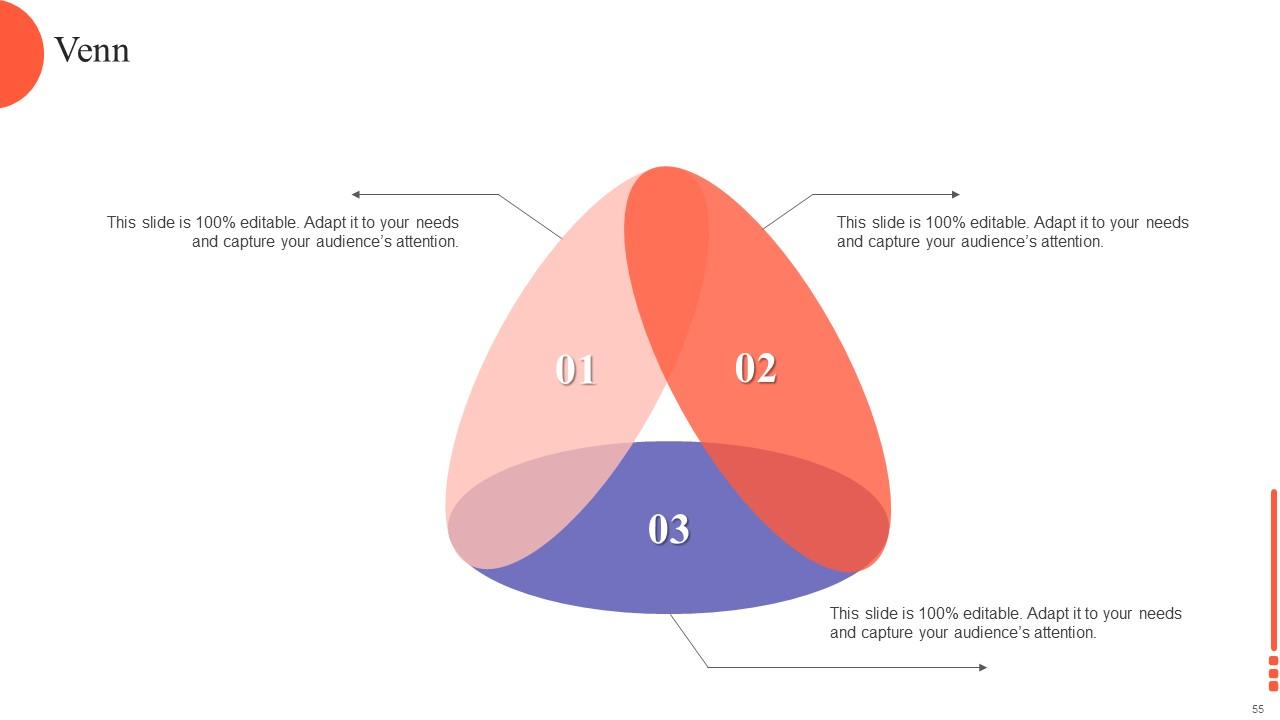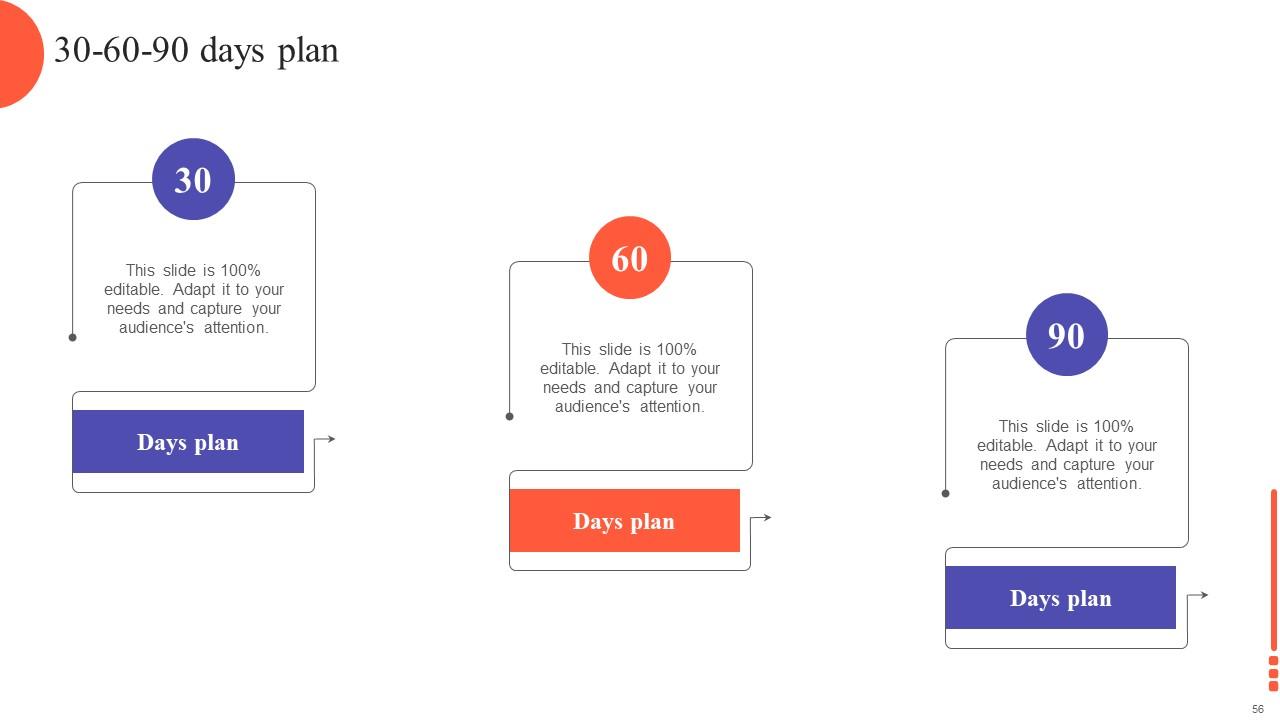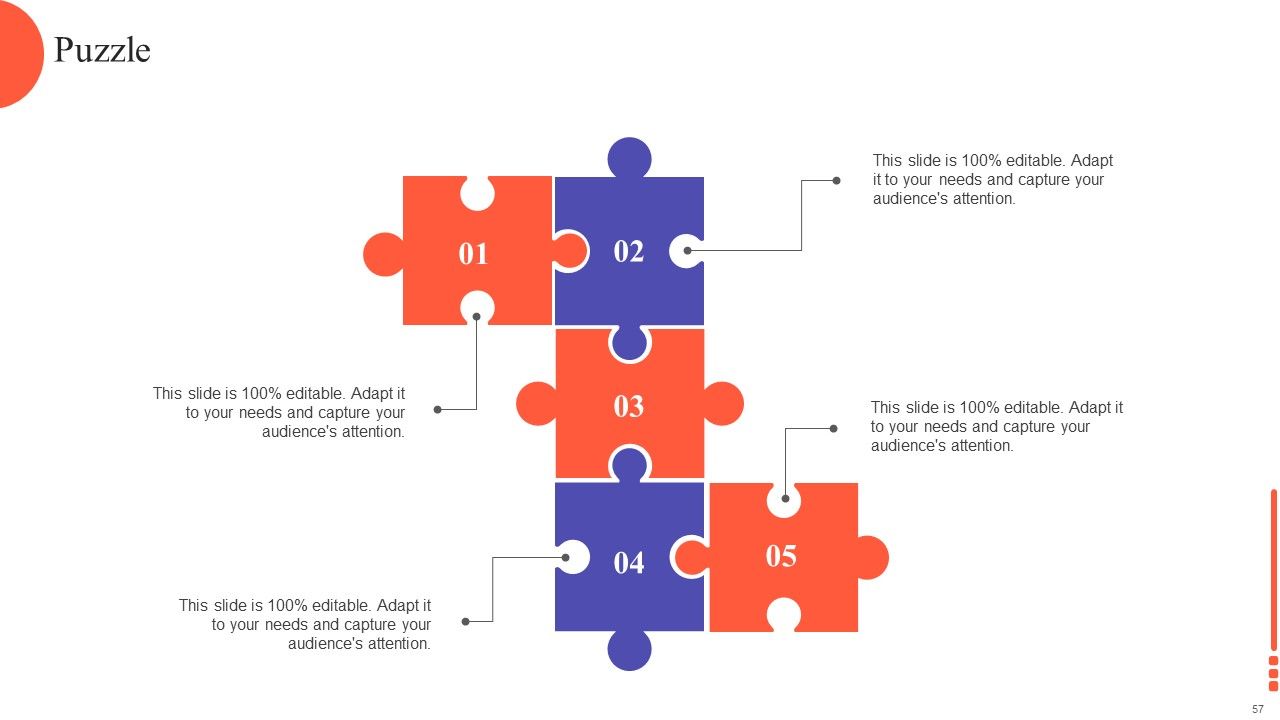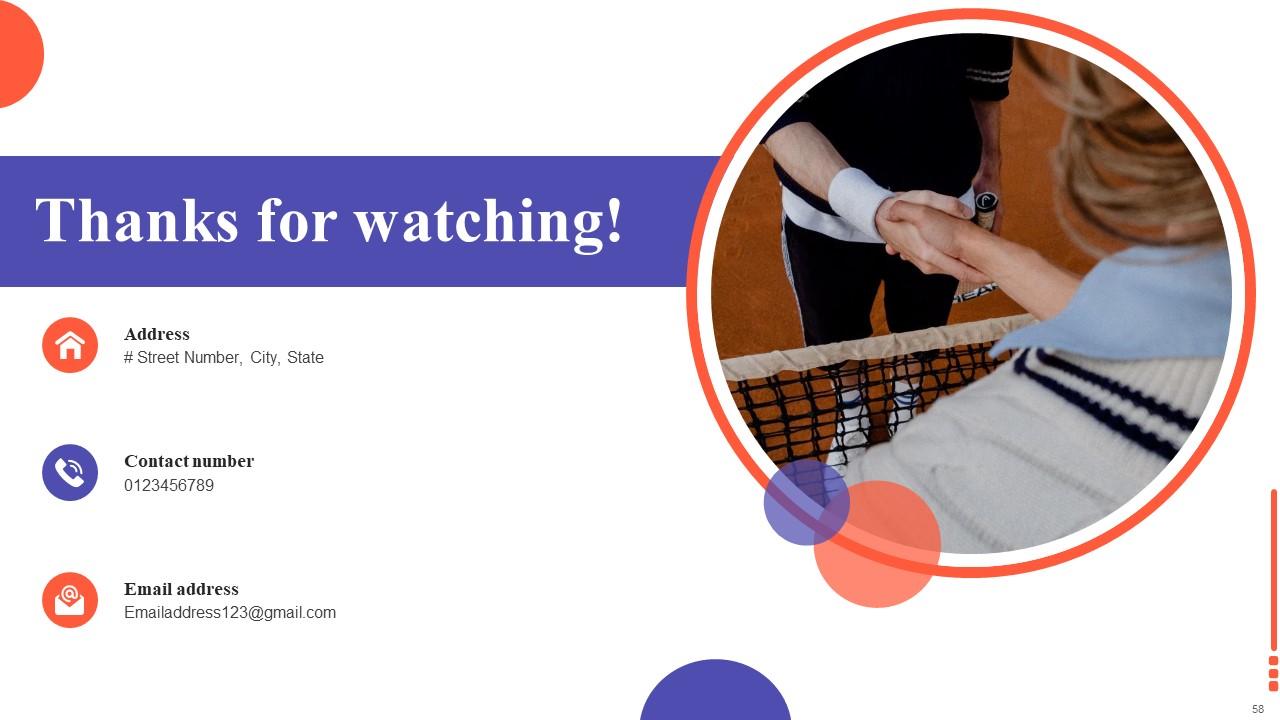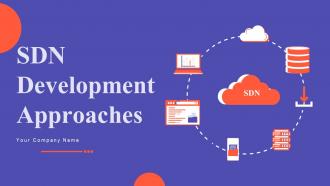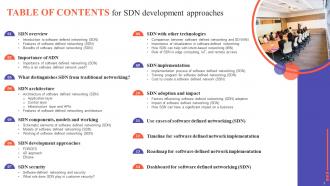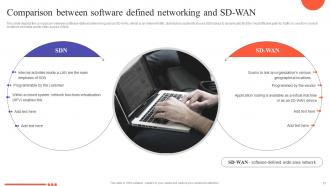SDN Development Approaches Powerpoint Presentation Slides
Grab our expertly crafted SDN Development Approaches presentation that provides an overview of software-defined networking SDN. It includes its introduction, features, benefits, and significance compared to traditional networking. Our SDN Overview deck covers the architecture of SDN, highlighting its layers, parts, components, and working principles. It also explores different development approaches for SDN, such as FORCES, 4D process, and Ethane, while emphasizing the role of SDN in enhancing customer security. The importance of SDN is discussed, including a comparison between SDN and SD-WAN, the role of virtualization in SDN, its relationship with intent-based networking IBN. Moreover, our SDN Components PPT covers SDNs impact on edge computing, IoT, and remote access. It also includes an implementation plan for SDN, a training program, and steps to create an SDN environment. Additionally, our SDN Security PPT features SDN use cases, a timeline and roadmap for SDN deployment, and a performance tracking dashboard. Download this 100 percent editable and customizable template, compatible with Google Slides, to effectively present the concepts and insights related to SDN.
Grab our expertly crafted SDN Development Approaches presentation that provides an overview of software-defined networking ..
- Google Slides is a new FREE Presentation software from Google.
- All our content is 100% compatible with Google Slides.
- Just download our designs, and upload them to Google Slides and they will work automatically.
- Amaze your audience with SlideTeam and Google Slides.
-
Want Changes to This PPT Slide? Check out our Presentation Design Services
- WideScreen Aspect ratio is becoming a very popular format. When you download this product, the downloaded ZIP will contain this product in both standard and widescreen format.
-

- Some older products that we have may only be in standard format, but they can easily be converted to widescreen.
- To do this, please open the SlideTeam product in Powerpoint, and go to
- Design ( On the top bar) -> Page Setup -> and select "On-screen Show (16:9)” in the drop down for "Slides Sized for".
- The slide or theme will change to widescreen, and all graphics will adjust automatically. You can similarly convert our content to any other desired screen aspect ratio.
Compatible With Google Slides

Get This In WideScreen
You must be logged in to download this presentation.
PowerPoint presentation slides
This complete presentation has PPT slides on wide range of topics highlighting the core areas of your business needs. It has professionally designed templates with relevant visuals and subject driven content. This presentation deck has total of fifty eight slides. Get access to the customizable templates. Our designers have created editable templates for your convenience. You can edit the color, text and font size as per your need. You can add or delete the content if required. You are just a click to away to have this ready-made presentation. Click the download button now.
People who downloaded this PowerPoint presentation also viewed the following :
Content of this Powerpoint Presentation
Slide 1: This slide introduces SDN Development Approaches. Commence by stating Your Company Name.
Slide 2: This slide depicts the Agenda of the presentation.
Slide 3: This slide includes the Table Of Contents.
Slide 4: This slide highlights the Title for the Topics to be covered further.
Slide 5: This slide represents the introduction to software-defined networking that helps network managers to manage network resources faster.
Slide 6: This slide depicts the features of software-defined networking that is intended to make a network more versatile and manageable.
Slide 7: This slide talks about the benefits of software-defined networking, including control, efficiency, management, and visibility.
Slide 8: This slide reveals the Heading for the Contents to be discussed next.
Slide 9: This slide shows the importance of software-defined networking that allows network administrators to design, create, and run their networks innovatively.
Slide 10: This slide depicts why the software-defined network is used.
Slide 11: This slide portrays the Title for the Ideas to be covered in the upcoming template.
Slide 12: This slide represents the comparison between software-defined networking and traditional networking based on their working methods.
Slide 13: This slide highlights the Heading for the Ideas to be discussed next.
Slide 14: This slide represents the software-defined networking architecture.
Slide 15: This slide talks about the application layer of the SDN architecture that includes the network applications and functions that businesses deploy.
Slide 16: This slide outlines the control layer of SDN architecture.
Slide 17: This slide presents the infrastructure layer and application programming interfaces of SDN architecture.
Slide 18: This slide shows software-defined networking architecture features.
Slide 19: This slide includes the Title for the Contents to be covered further.
Slide 20: This slide represents the schematic elements of software-defined networking.
Slide 21: This slide depicts the software-defined networking models, covering open SDN, SDN by apis, SDN overlay model and hybrid SDN.
Slide 22: This slide describes the working of software-defined networking.
Slide 23: This slide portrays the Heading for the Topics to be discussed next.
Slide 24: This slide depicts the forwarding and control element separation methodology of SDN development and caters to the overview and deployment methods.
Slide 25: This slide represents the 4D methodology of SDN development and includes the architecture and principles of the 4D approach.
Slide 26: This slide displays the ethane methodology of SDN development by covering its overview and principles.
Slide 27: This slide presents the Title for the Topics to be covered next.
Slide 28: This slide describes the security in software-defined networking.
Slide 29: This slide represents the role of software-defined networking in customer security.
Slide 30: This slide shows the Heading for the Contents to be discussed further.
Slide 31: This slide depicts the comparison between software-defined networking and an SD-WAN.
Slide 32: This slide presents the importance of virtualization in software-defined networking and how they complement one another.
Slide 33: This slide describes how SDN can help with intent-based networking.
Slide 34: This slide represents the role of software-defined networking in edge computing, IoT, and remote locations to make them more accessible and less expensive.
Slide 35: This slide reveals the Title for the Ideas to be covered in the upcoming template.
Slide 36: This slide outlines the implementation process of software-defined networking.
Slide 37: This slide represents the training program for software-defined networking.
Slide 38: This slide depicts the cost of creating a software-defined network,.
Slide 39: This slide reveals the Heading for the Ideas to be discussed next.
Slide 40: This slide represents the factors influencing SDN adoption.
Slide 41: This slide shows the impact of software-defined networking.
Slide 42: This slide reveals the four critical areas where SDN can make a difference in an organization.
Slide 43: This slide contains the Title for the Contents to be covered further.
Slide 44: This slide represents the use cases of software-defined networking.
Slide 45: This slide displays the Heading for the Topics to be discussed next.
Slide 46: This slide talks about the timeline for software-defined network implementation.
Slide 47: This slide reveals the Title for the Topics to be coveerd further.
Slide 48: This slide outlines the roadmap for software-defined network implementation.
Slide 49: This slide portrays the Heading for the Contents to be discussed enxt.
Slide 50: This slide depicts the dashboard for the software-defined network.
Slide 51: This is the Icons slide containing all the Icons used in the plan.
Slide 52: This slide is used for showcasing some Additional information.
Slide 53: This slide incorporates the company's mission, vision, and goals.
Slide 54: This slide reveals the team-related information.
Slide 55: This is the Venn diagram slide.
Slide 56: This is the 30-60-90 days plan slide for effective planning.
Slide 57: This slide continues the 30-60-90 days plan.
Slide 58: This is the Thank You slide for acknowledgement.
SDN Development Approaches Powerpoint Presentation Slides with all 63 slides:
Use our SDN Development Approaches Powerpoint Presentation Slides to effectively help you save your valuable time. They are readymade to fit into any presentation structure.
FAQs
Software Defined Networking offers several benefits, including enhanced control over network resources, improved efficiency in managing networks, better network visibility, and streamlined network management processes.
Software Defined Networking differs from traditional networking in terms of its working methods. Traditional networking relies on the manual configuration of network devices, while software-defined networking centralizes control and management through software, enabling faster network resource management and greater flexibility.
The Software Defined Networking architecture comprises three main layers: the application layer, which includes network applications and functions deployed by businesses; the control layer, responsible for network control and policy enforcement; and the infrastructure layer, consisting of the physical network infrastructure and application programming interfaces (APIs) that enable communication between layers.
Software Defined Networking plays a crucial role in enhancing security by providing better visibility and control over network traffic. With centralized management and programmability, network administrators can implement security policies and protocols more effectively, detect and respond to threats quickly, and isolate and secure critical network segments.
Software Defined Networking is widely applicable across various scenarios. Some common use cases include improving network accessibility and cost-effectiveness in edge computing, Internet of Things (IoT), and remote locations; enabling intent-based networking for automated network management; and facilitating the implementation of secure and efficient software-defined wide area networks (SD-WANs).
-
“Excellent service from the customer support team when I wanted a slide that was a bit different from those on their standard menu. Super helpful.”
-
Templates are beautiful and easy to use. An amateur can also create a presentation using these slides. It is amazing.



